Gregory Freihofer wins 2nd place at the SAMPE CAMX student paper competition

Pictured from left to right: Samuel Tucker, Remelisa Esteves and Dr. Seetha Raghavan
Remelisa spent the summer and fall semesters interning at Boeing St. Louis, where she worked with researchers to optimize the piezospectroscopic method for commericial viability. Her work is part of the NSF funded INTERN program, which allows her to perform research outside of the academic lab setting while acquiring professional development experience. Faculty mentor, Dr. Seetha Raghavan, paid a visit to the site and met the researchers there. Thanks goes to Remelisa’s manager, Samuel Tucker, for his guidance, as well as Boeing collaborators, Hong Tat and Joseph Schaefer, for their support on this project.
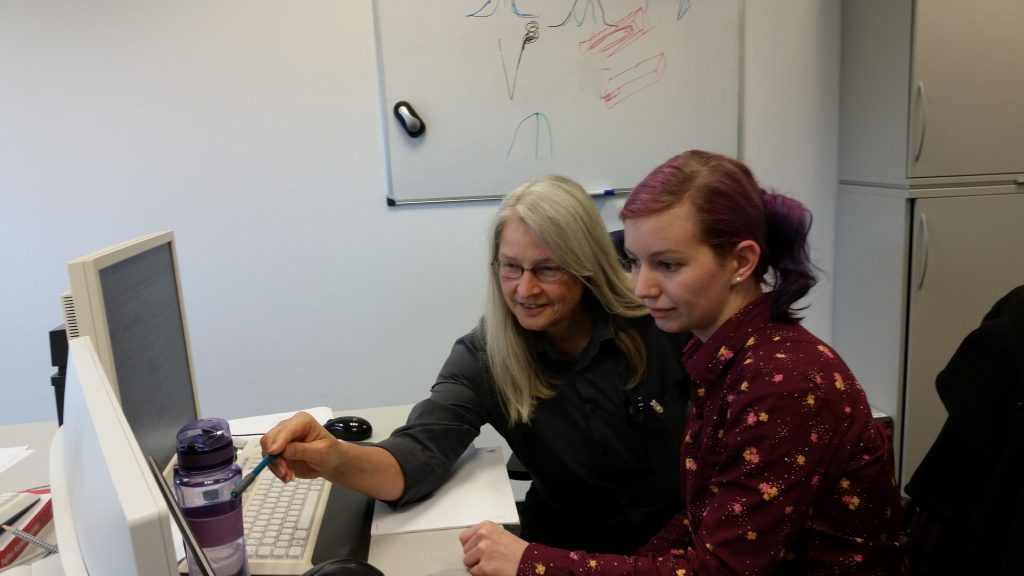
Dr. Bartsch and I discussing my work.
Hello all,
Thanks to winning a Fulbright student grant, I’ve been in Cologne, Germany since mid-September, conducting research for my masters’ thesis at the German Aerospace Center (DLR). I’m studying thermal barrier coatings (TBCs), which are coating systems used to protect the components in the hot section of gas turbine engines used for aircraft propulsion and power generation. I’m comparing two methods of depositing the ceramic top coat. Electron-beam physical vapor deposition (EB-PVD) is the industry standard method for producing the high-quality coatings used on the most critical hot-section components of aero-engines. The process involves vaporizing a solid ceramic target in a high vacuum, and the ceramic vapor condenses onto the part, which gives it a characteristic microstructure that is “strain tolerant” – less likely to crack with the repeated expansion and contraction associated with thermal cycles. Because the vapor must diffuse onto the coating, the process is slow, and the high vacuum requirement makes the process more difficult and expensive. The second process is plasma-spray physical vapor deposition (PS-PVD), which is a newer process that is faster, cheaper, and promises greater flexibility than EB-PVD. In this process, ceramic powder is injected into a plasma plume, where it is either melted or vaporized, depending on the process parameters. Because the plasma plume carries the ceramic to the part at high speed, the coating rate is much higher, and there is some non-line-of-sight capability, which will enable more complex part geometries or even multiple parts to be coated at once. Changing the process parameters also controls the resulting microstructure, which is relevant to applications beyond TBCs in engines – for example, gas-sending membranes or ion transport layers in fuel cells. Before PS-PVD TBCs can be adopted commercially, their properties and response to service conditions must be compared to EB-PVD TBCs. My work compares samples of both times, which have received varying amounts of thermal cycling to simulate low-, mid-, and high-lifetime coatings.
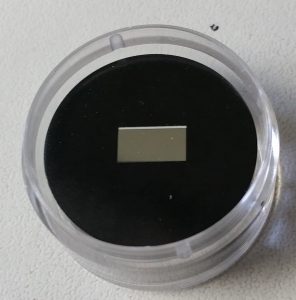
Embedded cross section of my dummy EB-PVD sample. That thin white layer is the TBC. The temperature drop across it can be as great as 200 °C (nearly 400 °F)!
I’ve been busy analyzing spectroscopy data that I’ve collected on my samples. Photoluminescent piezospectroscopy (PLPS) and Raman spectroscopy are non-destructive optical methods that provide information on the residual stress state of the coatings, which indicates remaining lifetime. Even more exciting, I’m planning my further testing with my mentor, Dr. Bartsch, here at DLR.
I’ll be imaging my samples with scanning electron microscopy and energy-dispersive x-ray spectroscopy. These techniques are time-consuming, expensive, and highly dependent on good quality sample preparation, so it’s critical to plan carefully and know what you’re looking for before you start. I’ll be using these techniques to support and explain my conclusions from my spectroscopy results. Dr. Bartsch has kindly provided me with some “dummy” samples similar to my own, for me to train and practice on. You don’t want to do a technique for the first time on your valuable samples, especially when it’s destructive!
I started by cutting a small piece from one of the dummy samples, embedding it in conductive mounting material, and polishing the cross section. The quality of surface finish is extremely important for good images. I took a few optical microscope images of the dummy, to check the surface finish and practice using the microscope. More surface preparation will be needed before I can image it with the electron microscope.
DLR is home to experts in the world of TBCs, and it’s a privilege to get their advice and feedback on my work. It’s a little surreal to have scientific conversations with some of the authors of papers I’ve read! Dr. Bartsch has a lot of expertise to share, not only on TBCs but also on the sample preparation and testing I’ll be doing. (Bonus: she’s the nicest lady you’ll ever meet.) At DLR, I also have access to a caliber of equipment that I wouldn’t have back at UCF, along with expert technicians and scientists to help me get the most out of it. And of course, the experience of living in another country and experiencing another culture is irreplaceable.
More updates later,
Lin Rossmann
Lab member Remelisa Esteves is currently interning with Boeing at St. Louis, Missouri from June 2018 to December 2018, where she is working alongside professional engineers to optimize the piezospectroscopic method for nondestructive testing of aerospace structures and commercial viability. We are proud to announce that Remelisa has been featured in the National Science Foundation’s (NSF’s) INTERN program video! Dr. Seetha Raghavan makes a cameo in this video as well.
Lab members Dr. Sandip Haldar, Quentin Fouliard, and Matthew Northam participated at the 2018 Department of Energy University Turbine Systems Research Program Conference held at Daytona Beach, FL from October 30- November 1, 2018. Matthew and Dr. Haldar presented 2D X-ray diffraction experiment results obtained at the Argonne National Laboratory in June of 2018 and Quentin presented his results on the optimization of temperature sensing coatings. These graduate students attended multiple talks over the three day conference relating to RDEs, TBC/EBCs, and turbine heat exchangers among others from experts in their respective fields.

Lab members (left to right) Matthew Northam, Quentin Fouliard, and DrSandip Haldar present there posters at the USTR Conference in Daytona Beach, FL.
Both Quentin and Dr. Haldar presented findings in collaboration with Dr. Ranajay Ghosh and his graduate student, Peter Warren shown in the below picture. Additionally, the results from this collaboration were also presented by Dr. Raghavan in a talk held on the second day of the conference.
Last year, the dynamic IRES 2017 team gave a podcast interview featured on our UCF MAE department website:
http://mae.ucf.edu/lend-me-your-engineers-podcast-episode-5/
Tune in and listen to their thoughts and adventures. Learn about how a summer of research in Germany can change your life.
The IRES applications for 2019 “US Germany collaboration in Materials for Extreme Environments” is open.
Read about previous participants and their adventures in their blog
https://aerostructures.cecs.ucf.edu/ires/blog/
Apply to be part of the next research adventure here:
https://aerostructures.cecs.ucf.edu/ires/apply/
Through a research collaboration with German Aerospace Center(DLR) in Cologne, Germany, both graduate and undergraduates have the opportunity to conduct research on the mechanics of aerospace materials. Requirements for applicants include being enrolled at UCF, and being able to enroll in directed research during the Spring and Summer 2019 terms as well as participating in research activities 10-20 hours a week. Students who are accepted will have the opportunity to work with leading scientists at a state of the art facility and be able to participate in industrial visits and cultural activities. Housing and a competitive stipend are provided. The deadline to apply is November 14th.
Graduate students Quentin Fouliard and Johnathan Hernandez participated at the 22nd AIAA International Space Planes and Hypersonic Systems and Technologies conference held in Orlando, FL from September 17-19, 2018. They attended talks related to hypersonics and took the opportunity to network with renowned experts in the field present at the event. In addition, they collaborated with AIAA UCF and NASA to set up interactive booths for the Generation STEM event which was part of the conference’s program.

Johnathan Hernandez (left) and Quentin Fouliard (right)
Lab members Khanh Vo, Sandip Haldar, Kyle Rushton, and Alexander Olvera volunteered at Generation STEM hosted by Lockheed Martin to engage and stimulate middle school students’ interest in the field of aerospace engineering. They worked with Asst Chief Engineer Teresa Kinney from KSC NASA to assist with her and Dr Raghavan’s Structural Dynamics technical committee booth as well as the AIAA UCF student chapter booth in the setup and the activity. The activity at the structural dynamics technical committee booth involved practical applications of dynamics in structures and the use of Chladni plates to explain the concepts of dynamics and vibration modes.

Pictured from Left to Right: Khanh Vo, Sandip Haldar, Erik Durnberg, Teresa Kinney, Alexander Olvera, and Kyle Rushton.
With AIAA UCF student chapter, they also demonstrated the benefits of the opportunities offered within the club and showed how kids can get a head start into the aerospace industry.
Graduate Student Quentin Fouliard participated in ICPT18, the 1st International Conference on Phosphor Thermometry held in Glasgow, UK, on July 25-27, 2018. Quentin presented a conference paper titled “Configurations for Temperature Sensing of Thermal Barrier Coatings” in which initial results on an optimization method to select rare-earth phosphors based on their thermo-mechanical and optical properties were discussed. He took this great opportunity to exchange knowledge with experts on Phosphor Thermometry and to share with them his findings as well as collecting suggestions for future improvements on this research.

Quentin is in the fifth position from the right in the furthest row.
Quentin is currently working on a project that is funded by the US Department of Energy and deals with the implementation of advanced instrumentation techniques for accurate temperature and stress monitoring on Thermal Barrier Coatings.
We are pleased to announce that three of our current and former lab members have published their paper “Silane functionalization effects on dispersion of alumina nanoparticles in hybrid carbon fiber composites” in the journal of Applied Optics.
Current and former lab members Alex Selimov, Sanjida Jahan, and Eric Barker worked in collaboration with scientists at Imperial College London, studying the effects of silane treatments on the dispersion properties of alumina nanoparticles in composite materials.
Lab member Zachary Stein has presented a poster on the research he has been conducting this summer as part of his participation in the Summer Undergraduate Research Fellowship (SURF), which he was awarded in April. Zac has been studying the effects of sand ingression on thermal barrier coatings and the research presented was on some initial analysis of the experiments conducted at Argonne National Laboratory this July.

Zac (center) presenting his poster “Synchrotron X-Ray Diffraction Study of CMAS Ingression in Electron-Beam Physical Vapor Deposition Thermal Barrier Coatings.”
Zac presented at the Summer Research Academy’s “Meet Student Researchers: Poster Showcase.” The Summer Research Academy introduces its participants to academic research and how to get started on conducting research themselves.
Lab member Debraliz Isaac-Aragones spent the summer at Purdue University in West Lafayette, Indiana participating in the Summer Undergraduate Research Fellowship (SURF) program. Her research focused on alternative thermal management solutions for electronic devices using thermal interface materials. She investigated the conduction pattern of particle-filled polymer composites using infrared microscopy. The experimental results were validated with both simulation software and theoretical relationships found in literature. She presented her summer’s work at the 2018 SURF Symposium.
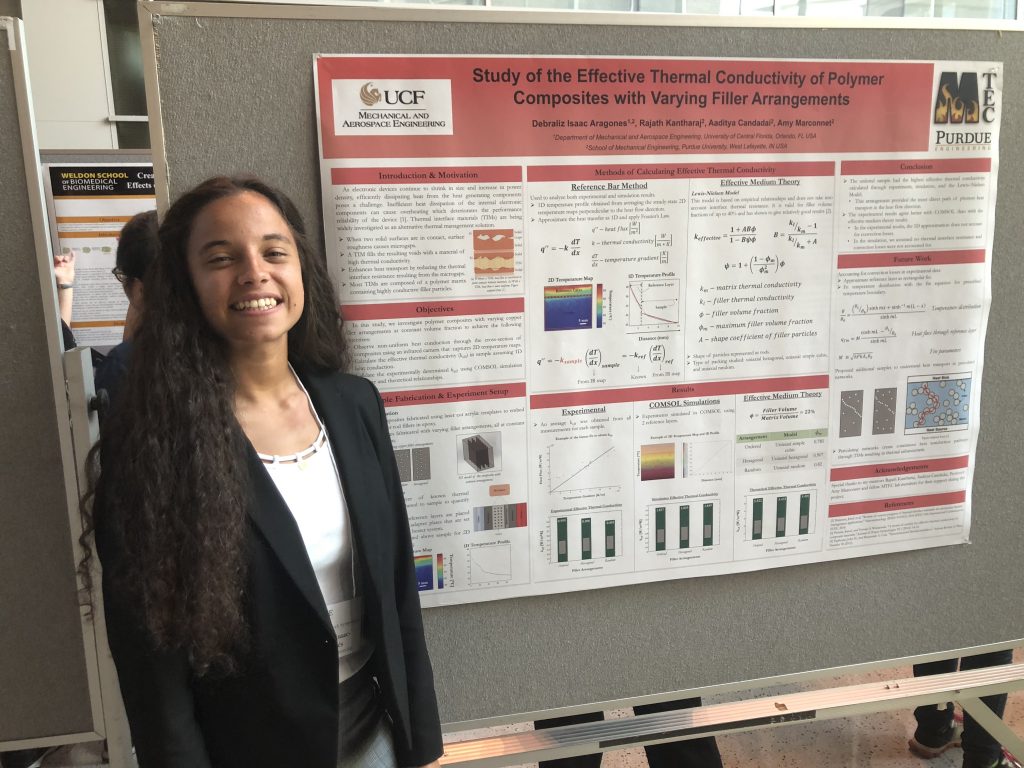
Debraliz presenting her topic ‘Study of the Effective Thermal Conductivity of Polymer Composites with Varying Filler Arrangements’ at the 2018 SURF Symposium.
Debraliz also participated in a program called Pathways that provided additional mentoring, networking, and professional opportunities for underrepresented students interested in pursuing a PhD. “We had several informal meetings where a small group of students and I engaged in discussion with faculty and graduate students. It has been a valuable experience to ask questions first-hand about what life is like in and after graduate school.” Overall, SURF gave her a better outlook on her future as a researcher.

Debraliz with a sculpture of Neil Armstrong at Purdue University.
Four students, three of them members of our lab, were part of a field team who recently conducted experiments at Argonne National Laboratory (ANL). Experiment campaigns at ANL are rigorous and demanding, but highly rewarding. The students reflect on their experience.
Matthew Northam, graduate student:
“I am, overall, very happy with how this year’s ANL trip went. Our group hit a few road blocks during the XRD experimentations, as to be expected, but everyone was constantly focused and determined to work together and get around the problems. Because the beam went down, we had to do twice as much work in the last day of experiments in order to reach our goals, but we came up with a new sample holder design and became more efficient regarding data collection and achieved our goals and then more. I couldn’t have asked for a better group of dedicated people to work with.”
Lin Rossmann, graduate student:
“Zac was our MVP, hands down. It’s impressive enough for an undergrad to be in charge of their own study, but not only did he do that, he also took the lead on our data analysis. With some help from the beamline scientists, he was able to analyze some of our XRD data to get strain information while we were still there. Being able to analyze data while the experiment is still ongoing is very important, because then you can be confident that your collection parameters are good, and if they’re not, you have time to fix it.”
Peter Warren, graduate student:
“To be able to go to Argonne National Lab and conduct experiments was an amazing and transforming experience. The entire trip was very enlightening, and was filled with excitement. I feel extremely lucky and blessed to have been a part of this trip. Being able to interact with some of the most brilliant scientists in the world felt quite surreal. This trip has given me both motivation and encouragement to continue my academic career in engineering.”
Zachary Stein, undergraduate student:
“It was definitely challenging to run my own study and ensure the best possible data was being produced, but the rest of the team was there assisting me along the way. Teamwork and on-the-spot problem solving is essential, meaning everyone must know each other’s projects as well as their own to be able to contribute fully. It was a week of important life lessons, but the most important of all is to keep a persistent, determined, and focused attitude so that no obstacles can stand in the way.”

Left to right: Matt Northam, Dr. Seetha Raghavan, Lin Rossmann, Dr. Ranajay Ghosh, Peter Warren, and Zac Stein.
Inaugural International Conference on Phosphor Thermometry, https://www.icpt18.org/
Lab member Quentin Fouliard will attend ICPT-2018 to present his paper, “Configurations for Temperature Sensing of Thermal Barrier Coatings.”
25-27 July 2018
Technology and Innovation Centre, University of Strathclyde
Glasgow, Scotland
We are proud to announce that Estefania Bohorquez has won second place in the Best Poster Award at Thermal Barrier Coatings V, a conference held by Engineering Conferences International (ECI). Her poster, titled “Raman studies on EB-PVD 7 wt% yttria-stabilized zirconia coatings with CMAS deposits,” is the result of a collaboration with the German Aerospace Center (DLR).

Estefania Bohorquez with her DLR collaborators.
The conference was held in Irsee, Germany from June 24 – 29, 2018. This is the first time the lab has been represented at this event, which occurs every 4 years and is highly competitive.
The collaboration with DLR developed from the NSF International Research Experience for Students (IRES) program. As part of IRES, Estefania was one of a group of students who spent a summer conducting research at a DLR facility. To read more about IRES, click here.
A team of researchers under Dr. Seetha Raghavan and Dr. Ranajay Ghosh has just returned from an experimental campaign at the Advanced Photon Source (APS) at Argonne National Laboratory (ANL). The experiments encompassed three different projects, each making use of the high-energy synchrotron x-rays of the APS to investigate the microstructure and physical properties of thermal barrier coatings (TBCs). TBCs are used to protect components in gas turbine engines from the extreme heat of combustion, and the team is contributing to their advancement in three areas.
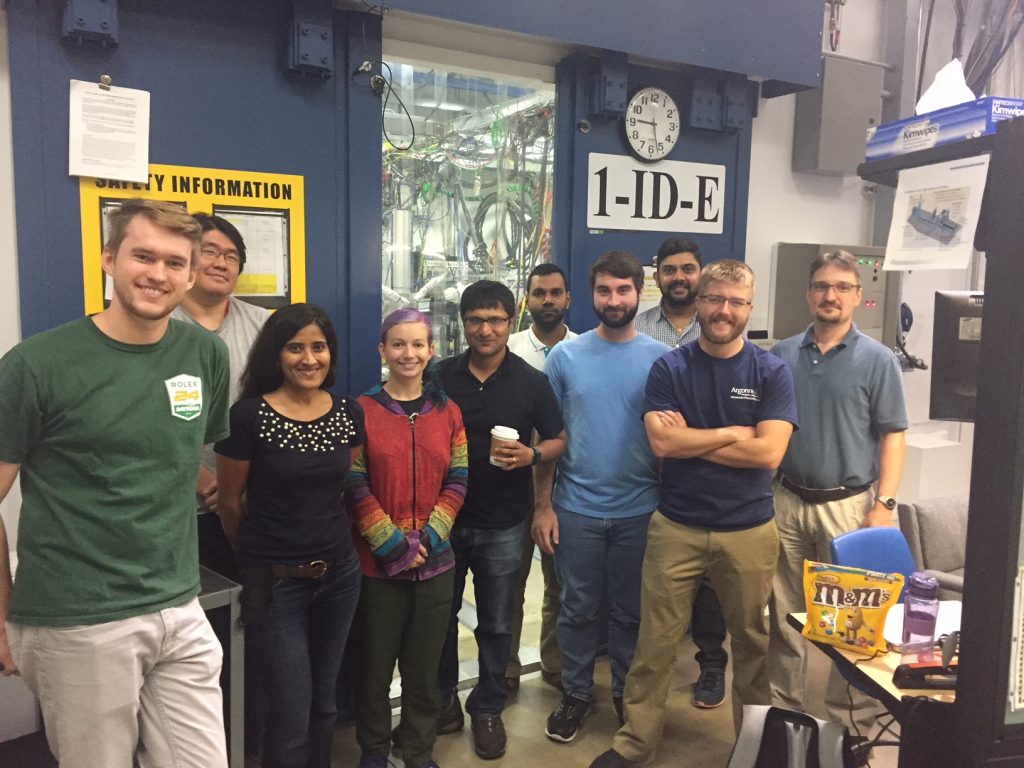
Left to right: graduate student Matt Northam, APS beamline scientist Jun-Sang Park, Dr. Seetha Raghavan, graduate student Lin Rossmann, Dr. Ranajay Ghosh, UCF postdoctoral fellow Dr. Sandip Haldar, undergraduate student Zac Stein, DLR postdoctoral fellow Dr. Ravi Naraparaju, graduate student Peter Warren, and APS beamline scientist Peter Kenesei.
The project led by graduate students Matthew Northam and Lin Rossmann encompasses investigating the properties of thermal barrier coatings produced by plasma-spray physical vapor deposition, a new and promising manufacturing method that may be more customizable and cost-effective than the current techniques in industry. This project is in collaboration with Dr. Bryan Harder of NASA’s Glenn Research Center; Matt and Lin visited Glenn in the spring semester to manufacture and begin testing these samples with Dr. Harder.
Postdoctoral fellow Sandip Haldar and graduate student Peter Warren led a Department of Energy-funded study on thermal barrier coatings doped with the rare earth element europium. Rare earth elements fluoresce when stimulated with certain wavelengths of light, and the duration of this fluorescence is dependent on temperature. A major objective of the DoE project is to implement rare-earth-doped TBCs such that the temperature inside an engine can be measured non-destructively and optically. The study performed at ANL will provide insight into how the addition of europium affects the mechanical properties of the TBC.
Undergraduate student Zachary Stein led a study investigating the effects of sand and ash on thermal barrier coatings. Fine debris like sand, dust, and ash causes damage to the TBCs in aircraft engines and shortens the engine lifetime, so understanding the nature of its effects is important to improving future coatings. This project is in collaboration with the German Aerospace Center (DLR), and DLR postdoctoral fellow Dr. Ravi Naraparaju joined the team for a day to discuss the project with Zac and Dr. Raghavan.
The team members from Raghavan Research Group were postdoctoral fellow Sandip Haldar, graduate students Matthew Northam and Lin Rossmann, and undergraduate student Zachary Stein; graduate student Peter Warren is a member of Dr. Ghosh’s research group. The team thanks the scientists at Sector 1 of the Advanced Photon Source who helped them: Dr. Jonathan Almer, Jun-Sang Park, Peter Kenesei, and Ali Mashayehki.
The AIAA Diversity Scholars Program provides scholarships for underrepresented university students to attend an AIAA forum. The scholars are given the chance to expand their network and learn about career opportunities in the aerospace industry. They get to learn from engineers and scientists about the latest research and development findings that are changing the future of aerospace. Additionally, there are special sessions designed to enhance the scholars’ experience.

Diversity scholars Debraliz Isaac, Maddie Moore, and Emma Chao win “Mars Rover” design competition at the Aviation Forum
Debraliz participated in many networking opportunities where she connected with representatives from companies such as NASA, Lockheed Martin, Aurora from Boeing, and many more! In the Plenary and Forum 360 sessions she got to learn about the different aspects of the aviation industry, from technical advancements to social, environmental, and economic effects. She attended many technical sessions from topics of aircraft design optimization to heat transfer in chemically reacting or extreme environments.
Debraliz’s favorite event was the Rising Leaders in Aerospace Panel on the topic of growing diversity in the aerospace sector. “It was inspiring to hear from accomplished professionals in the aerospace field about how they overcame challenges, as well as, their involvement in helping diversity grow in aerospace.”
Attending the Aviation Forum as a diversity scholar was a great way for her to get involved and learn about the aerospace industry.
Lab members Zac Stein, Khanh Vo, Matt Northam, and Sanjida Jahan hosted “The Balancing Act of Tensegrity” for Camp Connect II. This activity introduces the students to the concept of tensegrity – the principle of a structure that contains stiff members in compression held only by elastic members like cables, string, and rubber bands.
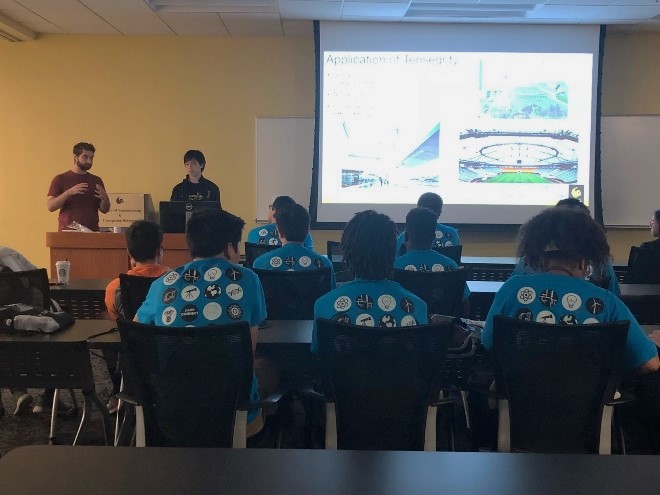
Zachary Stein (left) and Khanh Vo presenting to the students of Camp Connect.
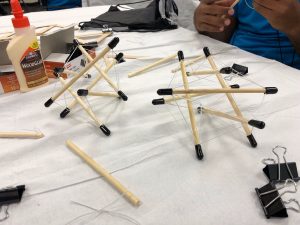
Students participating in the activity successfully created basic tensegrity structures.
Camp Connect is a week-long summer camp at UCF that introduces students in 8th grade and high school to a variety of engineering disciplines and encourages careers in STEM. Students participate in various activities and presentations with the help of both faculty and students.
Lab members Remelisa Esteves and Sanjida Jahan spent a week at Lumium in Leeuwarden, the Netherlands to train with optical instrumentation for their respective projects. They are collaborating with Dr. Bauke Heeg, who is developing a piezospectroscopic imaging (PSI) system for Remelisa’s Partnership for Innovation (PFI) project funded by the National Science Foundation (NSF), as well as a phosphor thermometry (PT) system for Sanjida’s Department of Energy (DoE) project funded by Siemens.
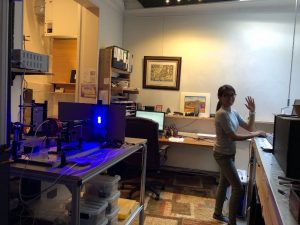
Remelisa performs tests with the piezospectroscopic imaging system.
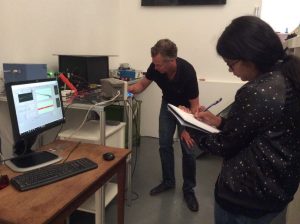
Dr. Heeg (left) and Sanjida (right) perform tests with the phosphor thermometry system.
Lumium is a sole-proprietary business, founded and owned by Dr. Heeg, that develops advanced laser and non-laser based optical instrumentation for science, engineering and industrial applications. For more information, visit www.lumium.nl.
Remelisa Esteves presented her technical paper at the Society for the Advancement of Material and Process Engineering (SAMPE) conference in Long Beach, CA, held May 21 – 24, 2018. She presented her topic “Piezospectroscopic coatings: Effects of alumina nanoparticle volume fraction on stress-sensing,” in which she is first author.

Remelisa Esteves at the SAMPE conference.
SAMPE is a global professional member society that provides educational opportunities pertaining to new and advanced materials and processing technology. At the conferences, scientists, engineers and students can present their research, attend talks, network, and participate in professional development workshops. For more information on SAMPE, visit https://www.nasampe.org/.
Our undergraduate student Khanh Vo attended the Partnership for Innovation/Small Business Innovation Research (PFI/SBIR) conference, held June 4-6 in Atlanta, Georgia. Khanh and collaborator Dr. Axel Schϋzlgen presented a poster titled “Multi-Scale and In-Situ Sensing Technology for Structural Integrity.” This poster gives a brief description of how the stress-sensing coating operates and the potential it has in industry.
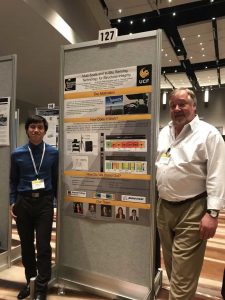
Khanh Vo (left) and Dr. Schülzgen present their poster at the PFI/SBIR conference.
Khanh participated in the “Perfect Pitch Competition” as part of the PFI conference. He also attended sessions that provided knowledge vital to pitching, knowing the customer base, team core values and working with large companies.
Partnership for Innovation and Small Business Innovation Research is a significant conference for academic researchers and aspiring startups who want to bring their research and projects out into industry as a commercially viable product.
SAMPE Conference and Exhibition, https://www.sampeamerica.org
Lab member Remelisa Esteves will attend SAMPE 2018 to present her paper, “Piezospectroscopic coatings: Effects of alumina nanoparticle volume fraction on stress-sensing.”
Conference: May 21-24, 2018 Exhibition: May 22-23, 2018
Long Beach Convention Center
Long Beach, California

Matt and Lin on their first day at Glenn.
Lab members Matt Northam and Lin Rossmann are spending two weeks at NASA Glenn Research Center to manufacture and characterize samples. They are collaborating with Dr. Bryan Harder of NASA Glenn, investigating a new method of depositing thermal barrier coatings (TBCs) for turbine engines.
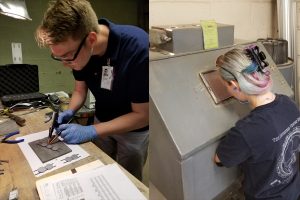
Matt spot-welds samples to a mounting plate for coating. Lin grit-blasts the plate clean after a round of coating.
Matt and Lin are learning many skills, including spot welding, grit blasting, and using characterization techniques such as powder x-ray diffraction and profilometry. They have been given tours of other facilities at Glenn and are learning about life as an experimental scientist at a NASA research center.
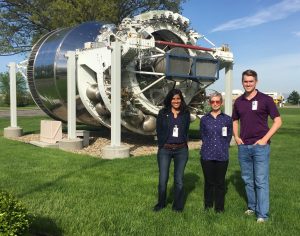
Dr. Raghavan poses with Matt and Lin in front of a Shuttle/Centaur G-Prime upper stage rocket engine on display at Glenn. Dr. Raghavan joined the students for three days of their trip.
NASA John H. Glenn Research Center at Lewis Field is one of ten major NASA field centers; its primary mission is to develop science and technology for aerospace applications.
Lab member Zachary Stein will spend the fall 2018 semester attending classes at the Zurich University of Applied Sciences (ZHAW) in Switzerland. ZHAW was founded in 1874 as a technical school for mechanical engineering, and has since become one of Switzerland’s largest engineering schools.
While in Switzerland, Zac will continue his research projects remotely. He will prepare a presentation on his summer project investigating the effects of sand ingression on thermal barrier coatings, for which he was awarded a Summer Undergraduate Research Fellowship. He will also work with Khanh Vo, developing and 3D-printing stress-sensing composite materials; for this work, Zac and Khanh were awarded a grant from the Office of Undergraduate Research. Zac will present posters on both projects at the Showcase of Undergraduate Research Excellence in the spring of 2019.
We wish Zac the best during his time abroad and wish him safe travels.
Our lab members Zac Stein and Khanh Vo have been awarded a grant from the Office of Undergraduate Research in support of their project, Investigation on 3D printing stress sensing coatings on carbon composites for photoluminescence piezospectroscopy. The results will be presented at the Showcase of Undergraduate Research Excellence in the spring of 2019. They are continuing to make us proud; both Zac and Khanh presented research posters at the 2018 Showcase, and Khanh was awarded both Judges’ Choice and Audience Choice.
Khanh is mentored by Mohamed Abdelgader, Remelisa Esteves, and Sanjida Jahan. Zac is mentored by Estefania Bohorquez, Matthew Northam, and Lin Rossmann.
We are pleased to announce that our lab member Zac Stein has been awarded a 2018 Summer Undergraduate Research Fellowship in Track 1 – Emerging Scholar. He will be studying the effects of sand ingression on thermal barrier coatings, and will present a scientific poster at the UCF SURF showcase at the end of the summer.
The SURF program provides support to students across engineering, science, and technology disciplines to engage in research.
We are proud to announce that our lab member Debraliz Isaac-Aragones has been awarded a Summer Undergraduate Research Fellowship for 2018 from Purdue University. She will spend the summer at Purdue under the guidance of Dr. Amy Marconnet, studying the effective thermal conductivity of thermal interface materials using an infrared microscope. To learn more about the Purdue SURF program, click here.
The SURF program is designed to help students across engineering, science, and technology disciplines to discover a world of opportunity available to them through research.
The participants of this year’s International Research Experience for Students (IRES) program presented their research topics and progress to members of our lab. The IRES students are spending the spring preparing for a summer semester conducting research at German Aerospace Center (DLR) facilities in Germany.
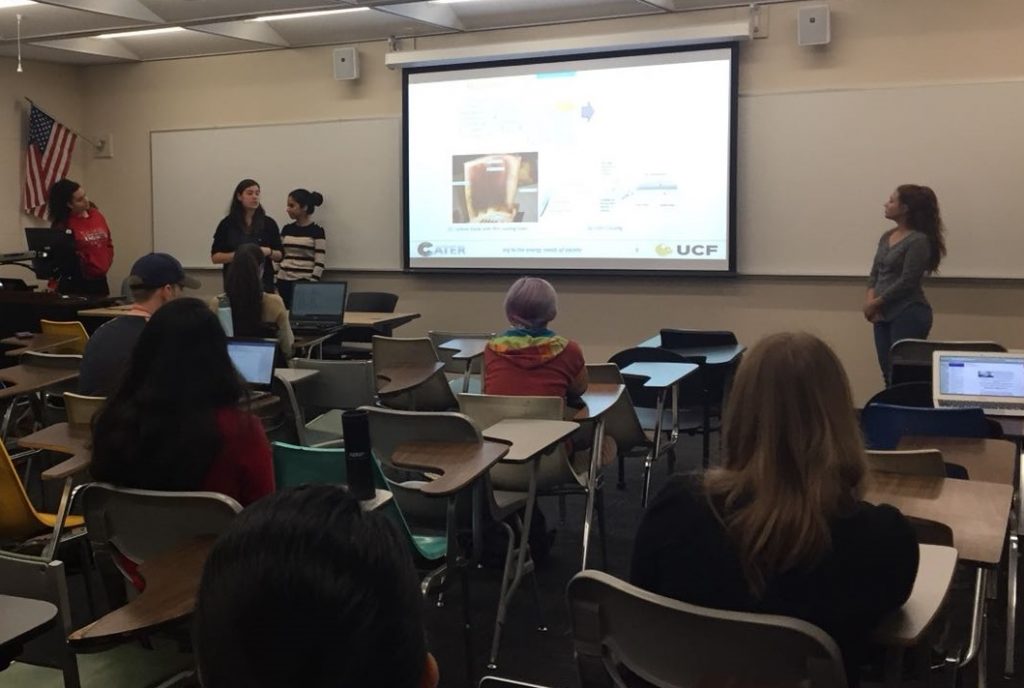
Michelle Otero (far left), Luisana Calderon (second from left), and Jalime Vargas (far right) present their diverse research topics to members of the Raghavan Research Group. Chance Barrett, not pictured, is the fourth IRES participant.
The IRES students are all members of research labs at UCF, and their participation is extending our network of collaborations. Michelle Otero and Jalime Vargas work under Dr. Kareem Ahmed at the Propulsion and Energy Research Laboratory (PERL), Luisana Calderon works under Dr. Jayanta Kapat at the Center for Advanced Turbine and Energy Research (CATER), and Chance Barrett works under Dr. Laurene Tetard at the Nanoscience Technology Center.
Follow along with the IRES students by reading their blog.
We are proud to announce that Khanh Vo has won the Audience’s Choice award at the Showcase for Undergraduate Research Excellence (SURE). This is the second award he has won at the competition (see previous post). He presented at the SURE event on the topic of “Spectroscopic Analyses of Composite Materials Using a Spectroscopic Portable System.” These positive outcomes are a result of joint lab group efforts, including Khanh’s graduate mentors: Remelisa Esteves, Sanjida Jahan, and Mohamed Abdelgader.

Khanh presents his award-winning poster, “Spectroscopy on Composite Materials,” at SURE.
SURE provides an opportunity for undergraduate students of all disciplines to present their research to the broader university community. For more information, click here.
The 2018 IRES team, with help from volunteers, hosted activities for UCF STEM Day. This year they had two groups of students; one from middle school and one from high school. Each group rotated through different stations where they learned about topics on heat transfer, spectroscopy, and gas turbine engines.
At the heat transfer station, the students learned about different heat transfer mechanisms through the use of thermochromic materials. A volunteer did a demonstration with thermochromic sheets made from thermochromic liquid crystals to show its color variation in response to temperature change.
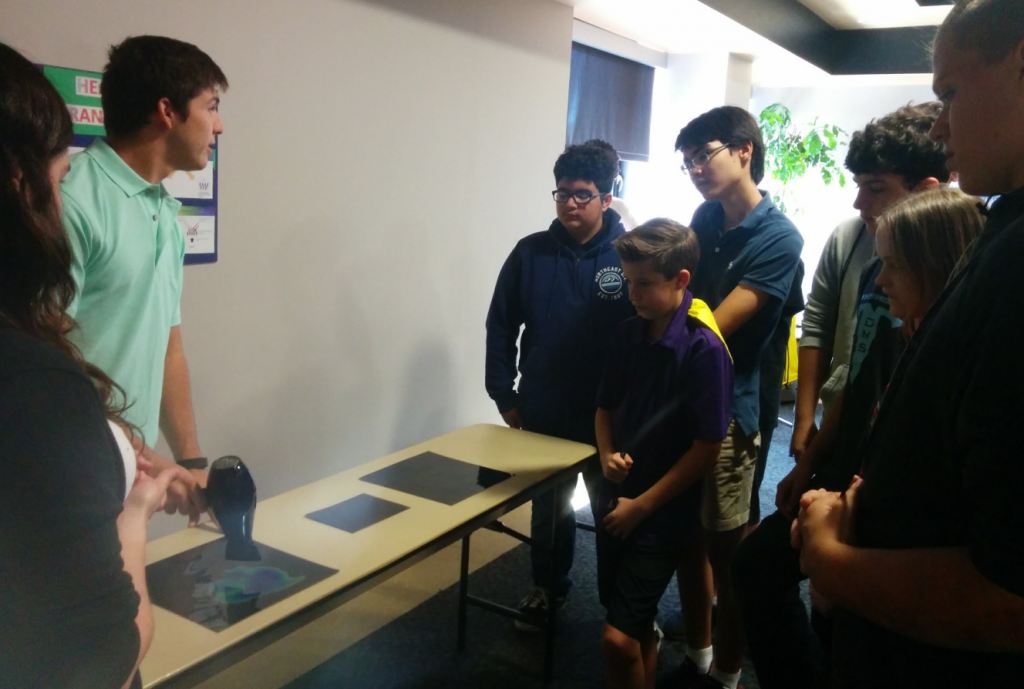
Juan Hernandez demonstrating the concepts of heat transfer with the use of thermochromic material.
At the next station, the students learned about non-destructive methods of testing through a spectroscopy demonstration. An IRES participant prepared spectrometers for the students to use to see the different color spectrum when exposed to various sources of light.
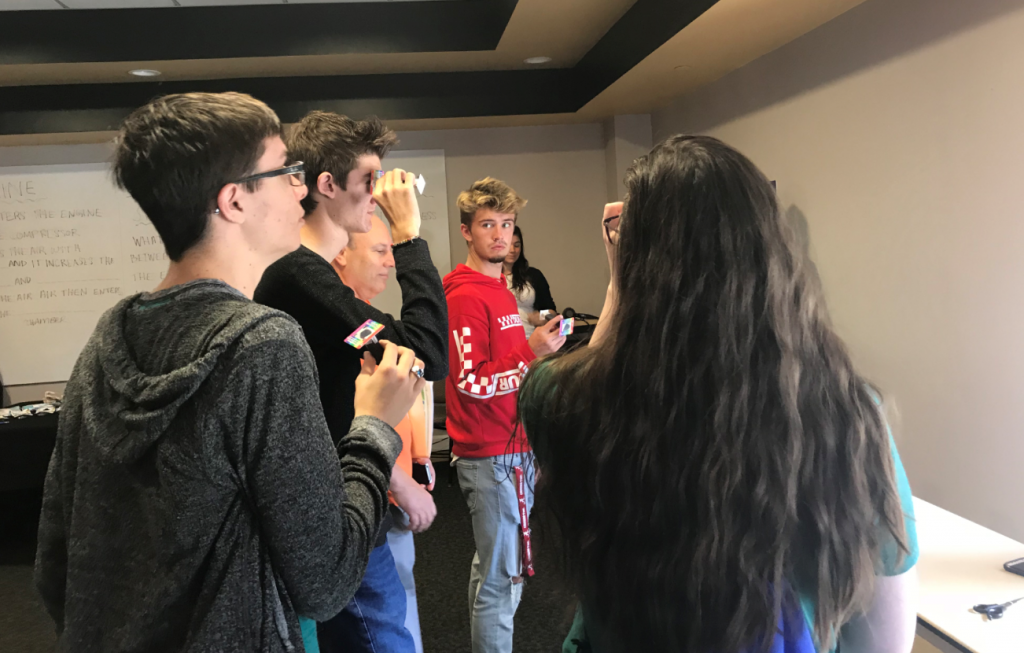
Students looking through spectrometers while IRES participant Chance Barrett explains basics of spectroscopy.
The final station consisted of posters showing a deconstructed gas turbine engine and “engines of the future”. One of the goals of this IRES STEM activity was to promote international collaboration through a language learning exchange. The IRES participants thought the students some technical and non-technical words pertaining to gas turbine engines in German. In addition, they discussed the functions of engines and the importance of using thermal barrier coatings to allow higher turbine inlet temperature, which enhances the thermal efficiency.
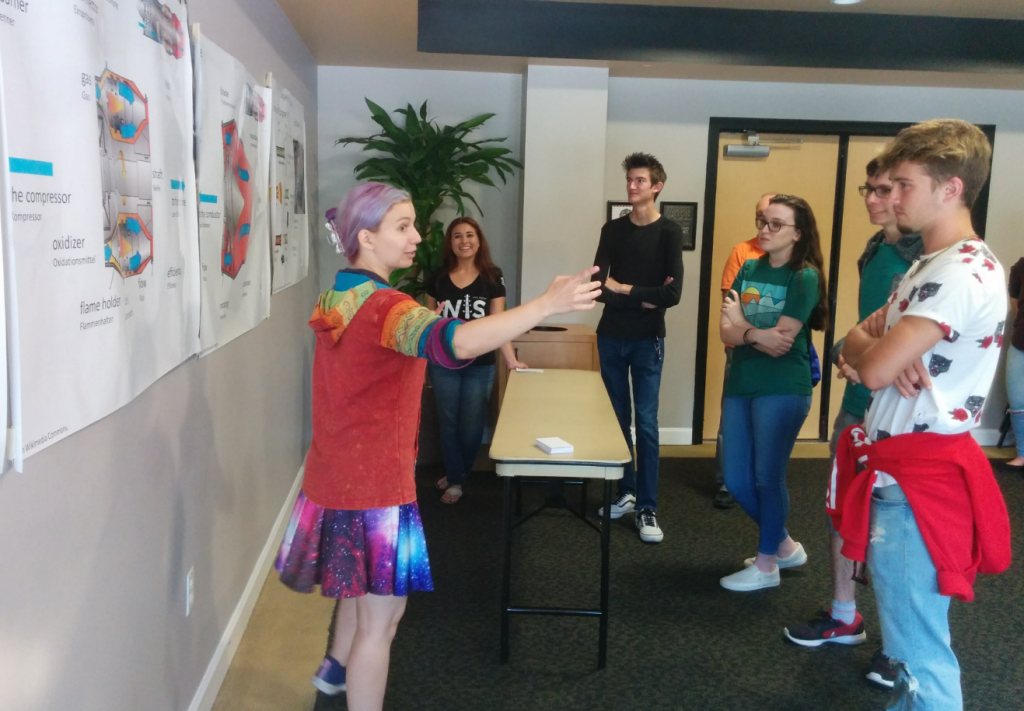
2017 IRES alum Lin Rossmann and 2018 IRES participant Jalime Vargas explaining gas turbine engines to the students.
At the end of the activity, the IRES participants asked the students questions on what they had learned and gave out prizes for correct answers. Overall, the students really enjoyed the activity!

Middle school students being asked questions at the end of STEM activity.
Special thanks goes out to all of our volunteers and the IRES students for coming together and making this activity possible.
We had:
Lin Rossmann, Debraliz Isaac, Estefania Bohorquez, Quentin Fouliard, Sanjida Jahan, Stephania Ochoa, Zach Stein, Susanne Henninger, and Ryan Hoover from the Raghavan Research Group.
Luisana Calderon (2018 IRES participant) and Juan Hernandez from the Center for Advanced Turbine and Energy Research (CATER) lab.
Michelle Otero and Jalime Vargas (2018 IRES participants) from the Propulsion and Energy Research Lab (PERL).
Chance Barrett (2018 IRES participant) from the Tetard Research Group, and Daniela Ojeda from the Mechanics of Materials Research Group.
We are pleased to announce that the National Science Foundation (NSF) has awarded Estefania Bohorquez a graduate research fellowship. Her field of study is Aeronautical and Aerospace Engineering.
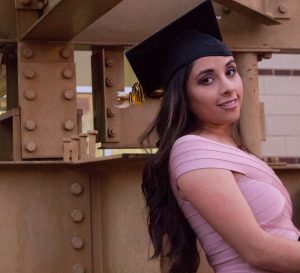
Estefania graduated from UCF with her bachelors’ degree in civil engineering in December 2017, and is now pursuing a masters’ degree.
The 2018 competition received over 12,000 applications and made 2,000 award offers. As the oldest graduate fellowship of its kind, the graduate research fellowship program has a long history of selecting recipients who reach high levels of success in their academic and professional careers. To learn more about GRFP, click here.
Our lab members Zac Stein and Khanh Vo each presented posters at the Showcase of Undergraduate Research Excellence this week. We are proud of them and their work, and we are delighted that Khanh was named the Judges’ Choice Winner. Both students, like all of our lab’s undergraduates, are being mentored by graduate students in our lab. Khanh’s mentors are Remelisa Esteves, Sanjida Jahan, and Mohamed Abdelgader, and Zac’s mentors are Estefania Bohorquez and Lin Rossmann.

Khanh Vo won the Judges’ Choice award for his poster, “Spectroscopy on Composite Materials.”

Zac Stein presented his poster, “X-Ray Diffraction Studies of CMAS Infiltration of Thermal Barrier Coatings.”
The Showcase provides an opportunity for undergraduate students of all disciplines to present their research to the broader university community. For more information, click here.
We are very proud to announce that two members of our lab, Estefania Bohorquez and Lin Rossmann, have been selected for Fulbright awards to Germany. They will spend ten months conducting research at the German Aerospace Center (DLR) facility in Cologne, beginning in September 2018.
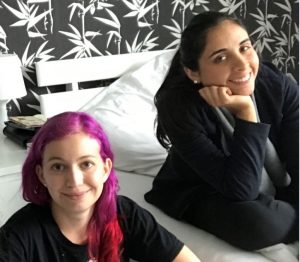
Lin Rossmann (left) and Estefania Bohorquez on their first day in Cologne as part of the IRES program in 2017. Their IRES experience was the reason for their decision to apply for Fulbright.
The two spent the previous summer conducting research at DLR Cologne as part of the International Research Experience for Students (IRES) program; they both credit their IRES experience as their motivation for applying for the Fulbright program. This year’s group of IRES participants are preparing for their own research in Germany in summer 2018; you can read about their activities at the IRES blog.
Estefania and Lin are following in the footsteps of former lab member Albert Manero, who was a 2014 Fulbright awardee at the same DLR facility in Cologne. To read more about the Fulbright program, click here.
Debraliz Isaac Aragones has presented a technical paper at the American Society for Engineering Education Southeastern (ASEE-SE) conference held March 4-6, 2018 at Embry-Riddle Aeronautical University Daytona Beach, Florida. Debraliz presented her topic as first author on “US-Germany Collaboration in Materials for Extreme Environments: Developing an International Research Pathway Towards Creating Global Engineers for the Future”. The paper discusses how the NSF-IRES: US-Germany collaboration develops students as global engineerings and can be found on the publications page of the website.
The ASEE conferences are dedicated to all disciplines of engineering education. They are committed to encouraging the exchange of ideas, enhancing teaching methods and curriculum, and providing networking opportunities.
Click here for more information about ASEE.
It is our pleasure to announce that lab member Estefania Bohorquez has been featured in the UCF Today’s article, “Woman of Wonder: Graduate Student and Aerial Acrobat Recognized for Aerospace Work”.
She is a winner of the 20 Twenties Award for 2018 and was also a participant of the IRES: US-Germany collaboration in 2017. Learn about Estefania’s journey and inspirations that have gotten her where she is now, on UCF Today.
We are thrilled to announce that our lab member Estefania Bohorquez is a winner of the 20 Twenties awards for 2018, and will be honored during Aviation Week’s 61st Annual Laureates Awards in Washington, D.C. in March.

Estefania graduated in December 2017 with a bachelor’s degree in Civil Engineering, and is now pursuing a master’s degree in Mechanical Engineering.
Lab member Lin Rossmann received an honorable mention, and will be published in the list of honorable mentions in Aviation Week Magazine’s digital February edition.
The 20 Twenties, held by Aviation Week Network in collaboration with the American Institute of Aeronautics and Astronautics, are meant to recognize and honor the twenty most promising future leaders in the aerospace industry. To read the official announcement of winners, click here.

2018 IRES participants, left to right: Chance Barrett, Luisana Calderon, Michelle Otero, Jalime Vargas.
The 2018 IRES team has been selected! Chance Barrett, Luisana Calderon, Michelle Otero, and Jalime Vargas have been chosen to participate in the IRES US- Germany collaboration. The students will spend the summer conducting research at the German Aerospace Center (DLR) facilities in Cologne and Stuttgart. To learn more about the program click here. Keep up with the 2018 IRES students through their blog page.
Estefania Bohorquez, Sanjida Jahan, and Lin Rossmann each presented a technical paper at the American Institute of Aeronautics and Astronautics (AIAA) SciTech Forum conference in Kissimmee, held January 8-12. Estefania presented her topic, “Investigation of the Effects of CMAS Infiltration on EB-PVD 7% Yttria-Stabilized Zirconia via Raman Spectroscopy.” Sanjida presented “Effect of Functionalization on Mechanical Properties of Hybrid Carbon Fiber Reinforced Polymer (HCFRP) Composites Using Piezospectroscopy.” Lin presented “Method for Conducting In-Situ High Temperature DIC with Simultaneous Synchrotron Measurements under Thermomechanical Load.” All three are first authors.
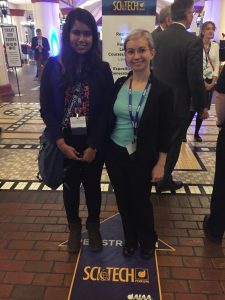
Sanjida Jahan (left) and Lin Rossmann at SciTech.
SciTech is a significant conference in the aerospace industry with many opportunities valuable to students. In addition to presenting their research, the students attended talks and participated in networking and career-development activities.
Lin’s favorite development event was the speed mentoring session, in which senior members of the aerospace community rotated among small groups of students. “I loved getting to talk to people from very different areas of the aerospace industry. My favorite piece of advice was that your career is not linear, and you should not be afraid to explore directions that don’t seem strictly related.”
For more information about SciTech, visit scitech.aiaa.org/About.
8-12 January 2018
Gaylord Palms, Kissimmee, Florida
IRES students Estefania Bohorquez, Owen Pryor, Lin Rossmann, and Brooke Sarley have been featured in UCF Today article “Going Global: UCF Engineers Shine Conducting Research Abroad”. The article can be found here, where you can read more about the impacts of conducting international research.
The research team’s US-Germany collaboration continues to grow as we welcome Susanne Henninger who is visiting from the Friedrich-Alexander Universität Erlangen-Nürnberg (University of Erlangen-Nuremberg). She has come to UCF to conduct research for her master’s thesis. She will be spending the spring semester researching additive manufactured superalloy CMSX-4. Her biography can be found here.
Applications due for IRES Germany Summer 2018
The University of Central Florida’s Center for Initiatives in STEM will host K-12 students on campus for its bi-annual STEM Day event on Oct 27. Our laboratory will be participating
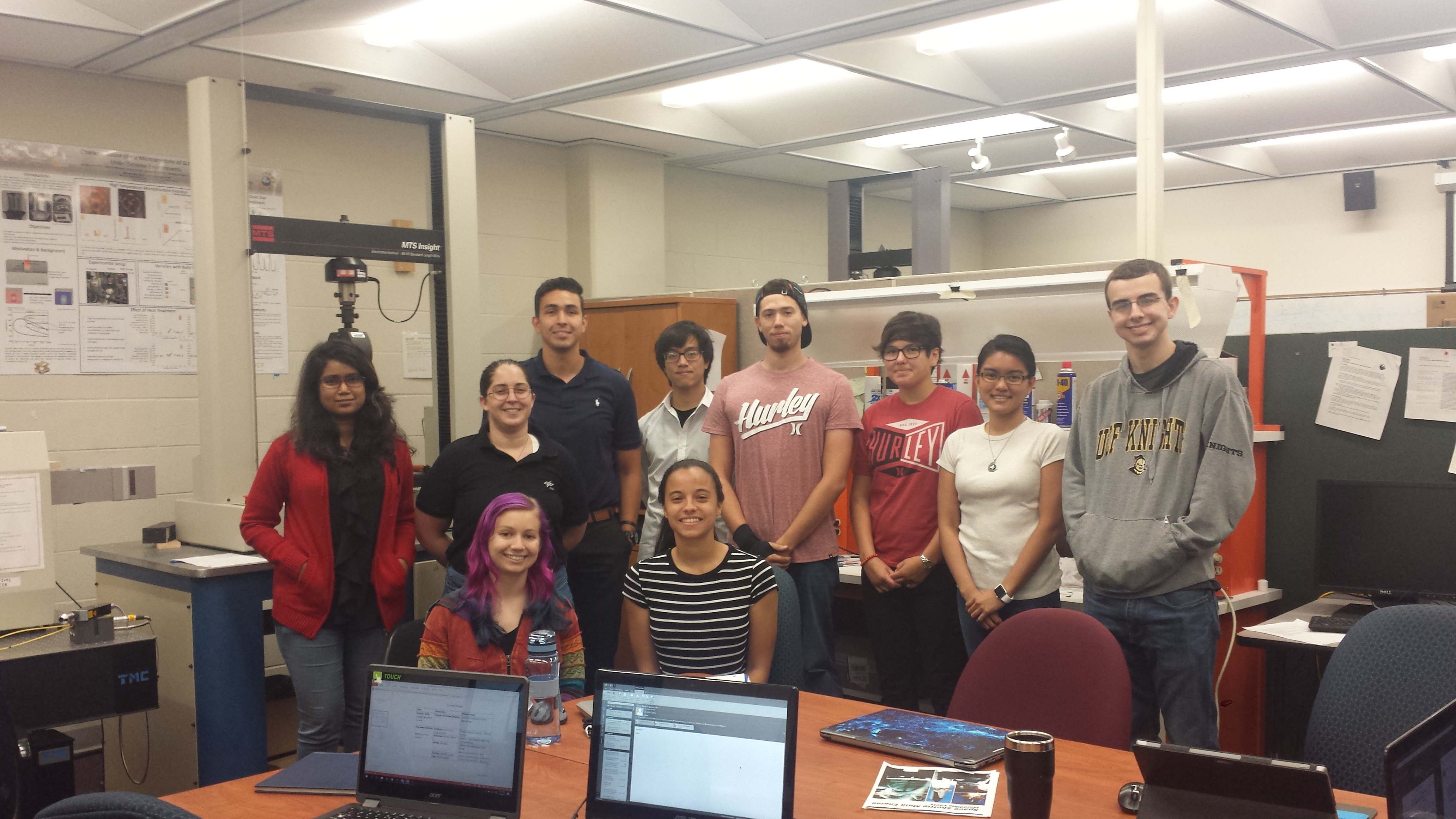

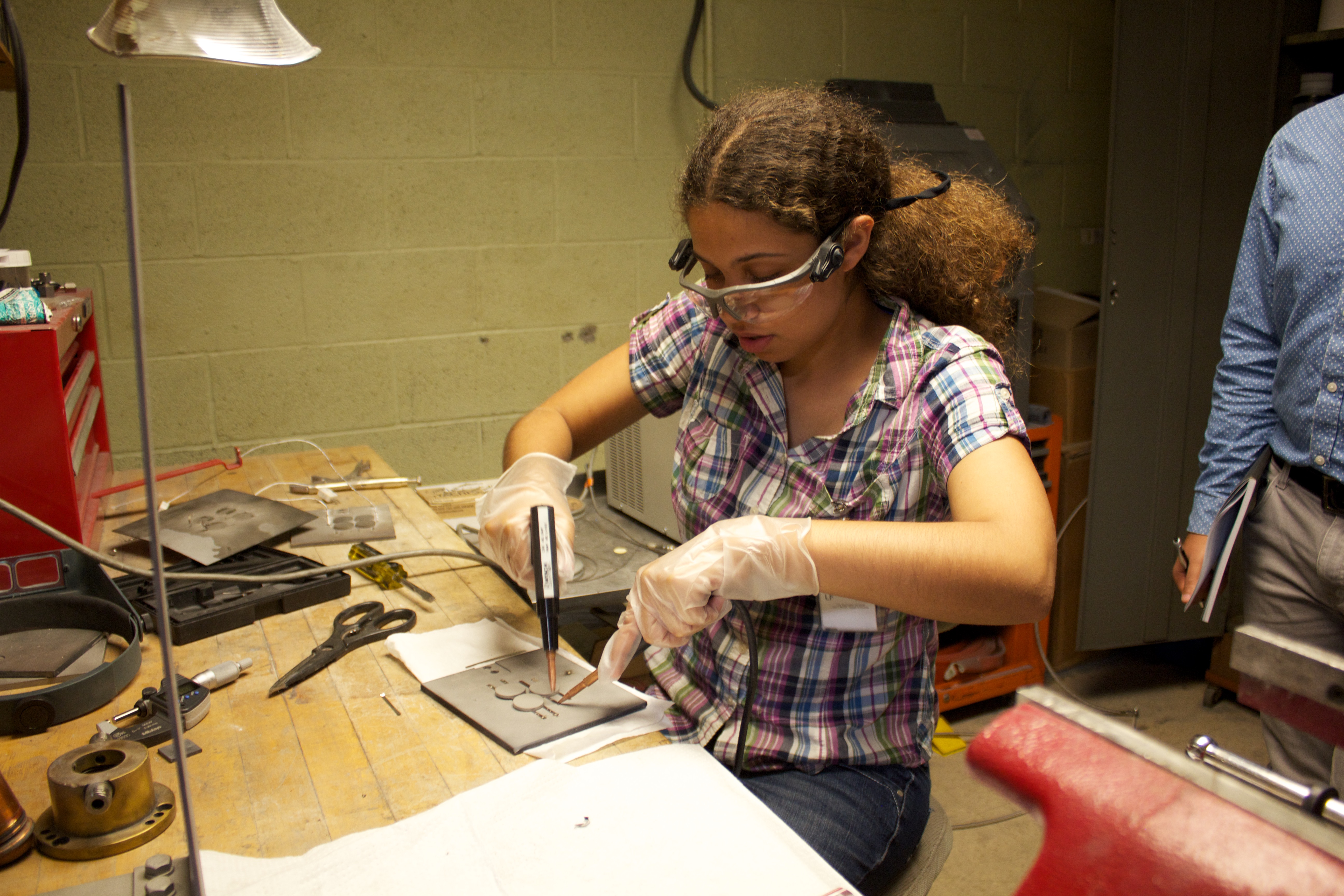


IRES Students at DLR received metallographic training to prepare samples for experimentation. These experiments are intended to support investigations being conducted at our Lab at UCF.

You can learn more about their experience and check out their blog here.
https://aerostructures.cecs.ucf.edu/international-research-experience-for-students-ires/ires-blog/
You can learn about the IRES program and how to gain an international research opportunity next summer here
https://aerostructures.cecs.ucf.edu/international-research-experience-for-students-ires/
Through the Summer Research Academy, four of our research students got the chance to promote our research lab to undergraduate students who were interested. They talked about their own personal experience with research as well as the projects they are working on. The attendees got a chance to learn about the equipment and posters in the lab as well. Also one of our research students, Khanh Vo, presented one of our posters at the Research Showcase.
Thank you Taiason Cole, Khanh Vo, Ryan Hoover, and Eric Barker
Our laboratory hosts Summer research academy participants
https://www.sra.ucf.edu
Camp Connect is a week-long day camp that introduces high school and middle school students to various engineering disciplines at the University of Central Florida. For Camp Connect we hosted “Shedding Light on Damage in Aircraft Structures”. We had 4 groups of 20 students, meaning we met up to 80 students in total. We started off by educating the students about spectrums and how we use light to test our materials and study their mechanical properties. Afterwards the students got into group of four and created their own spectroscopes. Spectroscopes are a tool used to split the wavelengths of lights into the colors that make them up also called spectrums. Once they created the spectroscopes we allowed the students to look at various light sources through the spectroscopes and record their observations. They got to look at fluorescent, incandescent, projector, computer, and their cellphone lights. Following the observations, they played a matching game where they compared different spectrums to the lights they observed and see how many they could match up. Two groups got all five spectrums correct. It was a great activity and the kids had a great time learning about light and understanding how it can be used to tell us about our materials.
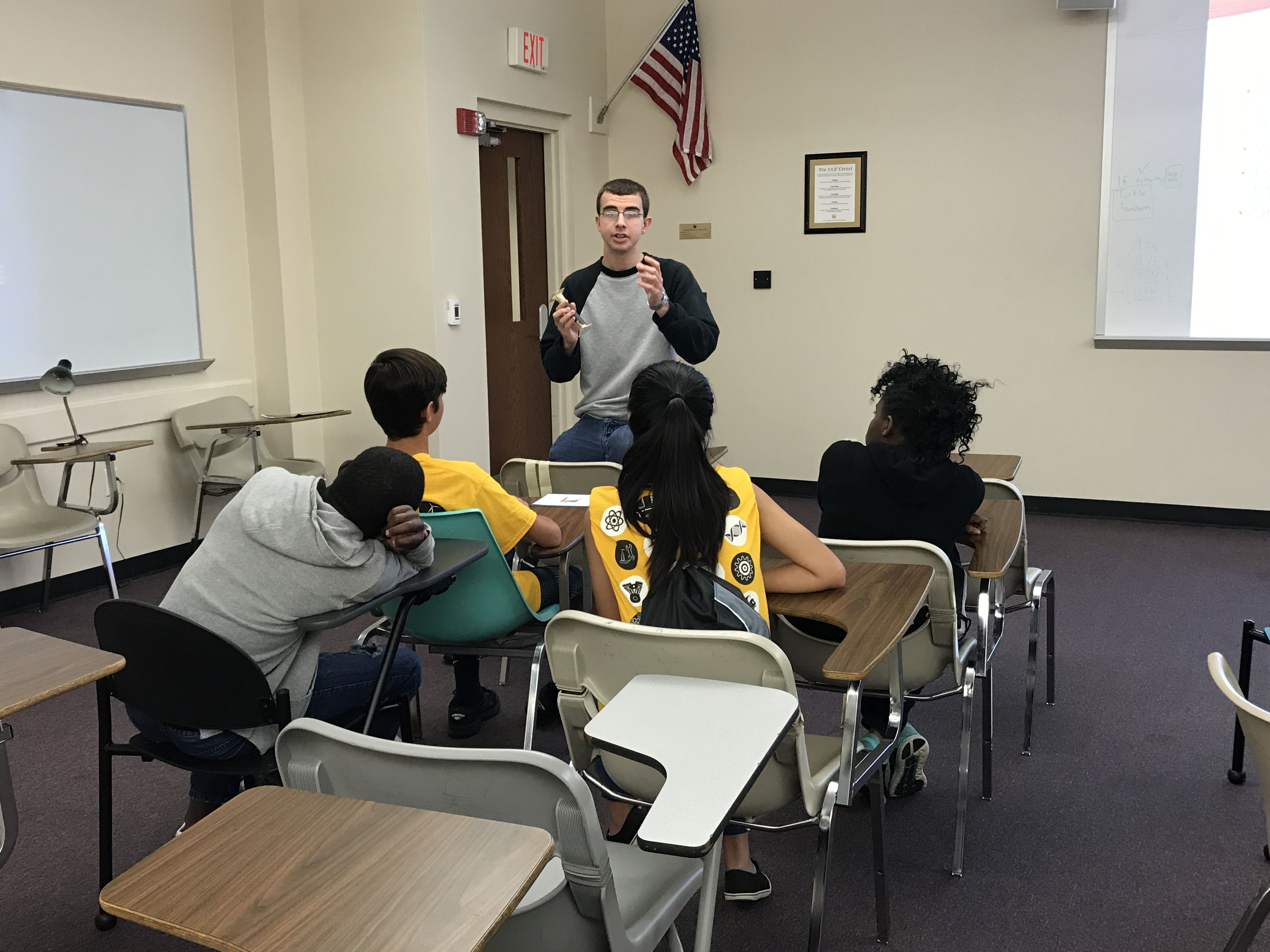


Special Thanks to Taiason Cole, Khanh Vo, Sanjida Jahan, Ryan Hoover, and Eric Barker
Lab group members Debraliz Isaac, Lin Rossmann, and Estefania Bohorquez depart today for Cologne, Germany to begin their IRES trip.
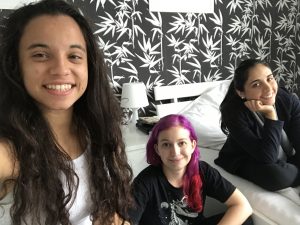
These students will spend the next 10 weeks at the German Aerospace Center (DLR) working with collaborators to perform experiments, put together publications, and learn from the international research experience. To learn more about their trip, visit the IRES page and read their blog.
Congratulations to our three lab members who were awarded Summer Undergraduate Research Fellowships by UCF. Taiason Cole was awarded under Track 1, Emerging Fellow, and will be analyzing x-ray diffraction data as part of an investigation to characterize additively manufactured Inconel 718. Eric Barker was awarded under Track 2, Fieldwork Fellow, and will be working with NASA’s Glenn Research Center for research on a new thermal barrier coating called PS-PVD. Brooke Sarley was awarded under Track 3, Publishing Fellow, and will be preparing a manuscript for publication based on research she has been conducting for several semesters on additively manufactured Inconel 718.
Lab members Eric Barker, Estefania Bohorquez, Jonathan Hernandez, Ryan Hoover, Lin Rossmann, and Brooke Sarley presented three research posters at the Showcase for Undergraduate Research Excellence (SURE) at UCF. SURE provides the perfect opportunity for UCF undergraduates from all disciplines to present their research and projects to the rest of the UCF community.
Eric Barker and Johnathan Hernandez presented on “Effects of Functionalization on Hybrid Carbon Reinforced Polymer Composites through Photoluminescence Spectroscopy.”
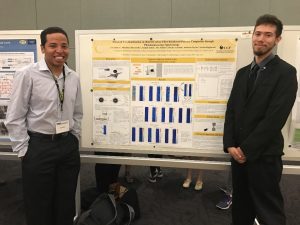
Eric Barker and Johnathan Hernandez
Estefania Bohorquez and Ryan Hoover presented on “Investigation of the Effects of Thermal Barrier Coatings via Piezospectroscopy.”

Estefania Bohorquez and Ryan Hoover
Lin Rossmann and Brooke Sarley presented their research on “Characterization of Additively Manufactured Inconel 718 for Extreme Environments through Synchrotron X-ray Diffraction.”

Brooke Sarley and Lin Rossmann
To read more about the event, click here.
As part of STEM Day at UCF, the IRES students, with help from other lab members, hosted two activities for groups of high school and middle school students. In one activity, a gas turbine engine was deconstructed into three different sections. The kids learned about how gas turbine engines work at the individual stations that highlighted the engineering of each section, with the help of a 3D-printed cutaway model (borrowed from the UCF chapter of ASME). To emphasize the international aspect of science and engineering, we taught them some common and technical words in German, and encouraged them to teach us relevant words in the languages they knew. The kids translated a total of 23 words in over 6 different languages!
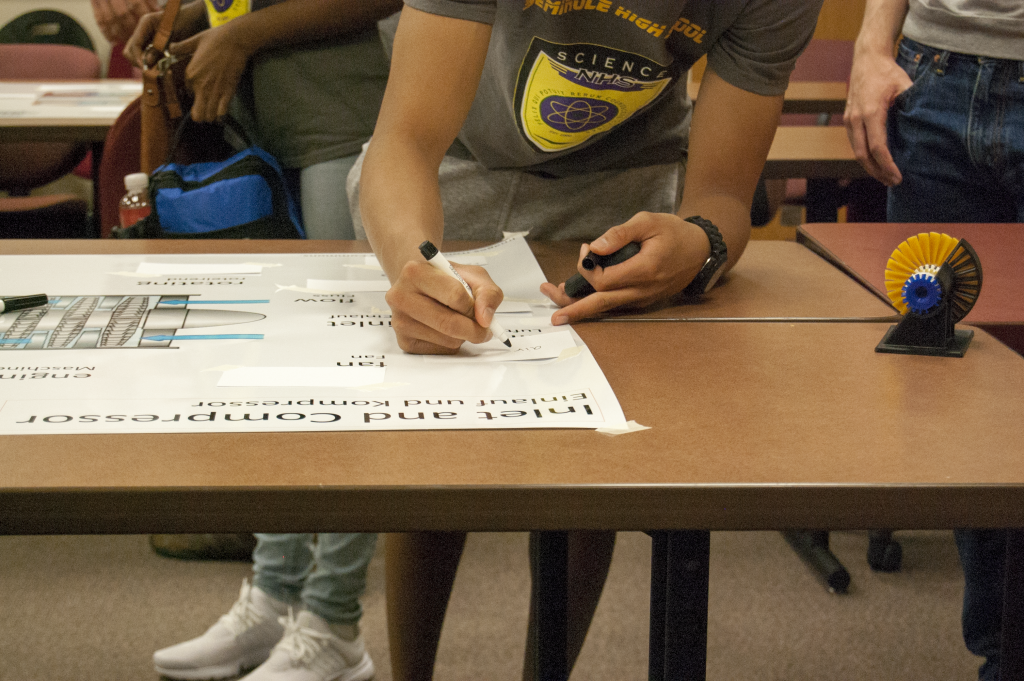
A student writes a translation of a word on a diagram of the inlet and compressor sections of a gas turbine engine. Also on the table is a 3D-printed cutaway model of a gas turbine engine.
In the second activity, the kids learned about spectroscopy and each built a simple spectroscope, which they got to take home with them. Spectroscopes are a simple tool to introduce kids to the field of spectroscopy, which is a powerful diagnostic tool for engineers as well as a scientific tool. One of our lab teams is using a type of spectroscopy called photoluminescent piezospectroscopy to investigate the effects of sand ingression on the coatings of turbine blades.

A student builds a spectroscope by taping a diffraction grating and a narrow slit of stiff paper to opposite ends of a dark tube.
The kids enjoyed themselves and learned a bit, and the volunteers have a fun time as well.
A special thanks to our volunteers: Sanjeev Ballapuram-Murali, Taiason Cole, John Hatchitt, Ryan Hoover, Cesar Lopez, and Brooke Sarley, and IRES students Estefania Bohorquez, Debraliz Isaac-Aragones, Owen Pryor, and Lin Rossmann.
All photos by Paul Kelly, Department of Mechanical and Aerospace Engineering, UCF
UCF’s Showcase of Undergraduate Research
https://www.showcase.ucf.edu
Albert Manero, an alumnus of our laboratory, continues to make us proud as he receives the Christine Mirzayan Science & Technology Policy Graduate Fellowship.
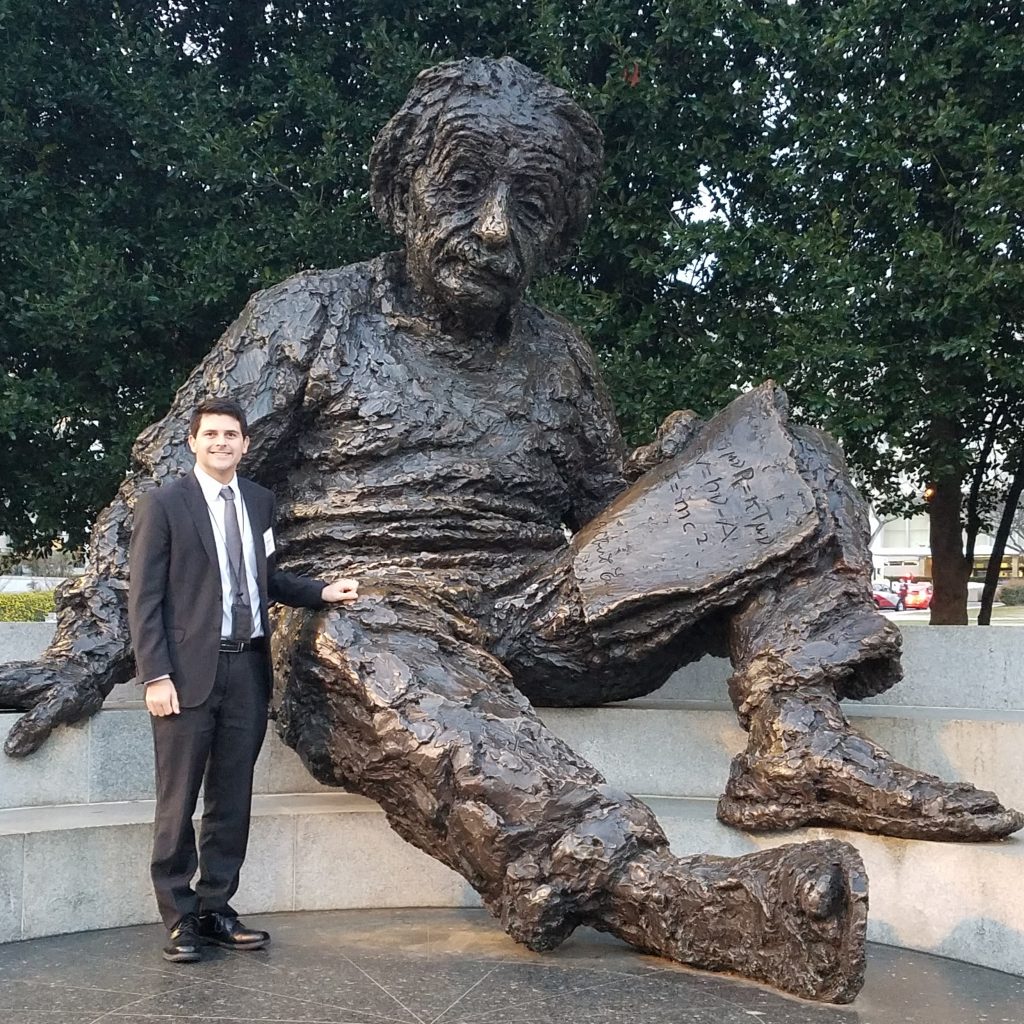
The fellowship operates under the Policy and Global Affairs Division of the National Academies of Science, Engineering and Medicine. It provides awardees with the opportunity to spend 12 weeks in Washington, D.C., learning about the role scientists and engineers play in informing national policy. We wish Albert the best of luck in this exciting and empowering opportunity.
Read about Albert’s experience here.
Learn more about the Christine Mirzayan Science & Technology Policy Fellowship here
Today is the International Day of Women and Girls in Science, a day established by the United Nations to recognize the critical role that women and girls play in science and technology. Our laboratory’s collaboration with the German Aerospace Center is a great example of what can be achieved when women scientists, researchers, and students come together. Last November, the team from UCF gathered with German Aerospace Center (DLR) scientists at the Advanced Photon Source at Argonne National Laboratory (ANL) to perform some unique experiments.
 The team conducted synchrotron x-ray diffraction on samples of additively manufactured superalloys under thermomechanical loading. To read more about their work, click here. To view photos of past ANL teams, click here.
The team conducted synchrotron x-ray diffraction on samples of additively manufactured superalloys under thermomechanical loading. To read more about their work, click here. To view photos of past ANL teams, click here.
Estefania Bohorquez, Debraliz Isaac-Aragones, Owen Pryor, and Lin Rossmann have been selected to participate in the 2017 IRES US-Germany collaboration to advance research and education in materials for extreme environments.

L to R: Estefania Bohorquez, Debraliz Isaac-Aragones, Lin Rossmann, Owen Pryor
The students are preparing for the 10-week NSF-funded summer program dedicated to conducting research on the mechanics of aerospace materials for extreme environments. Through partnership with the German Aerospace Center (DLR), students will gain research experience at state-of-the-art facilities in Cologne and Stuttgart, Germany with leading industry scientists and will develop professionally in an international environment. This program will be offered again in summer 2018, with the application period taking place during the fall 2017 semester.
Keep up with the students’ experiences as they prepare for their summer research collaboration on their blog page: [link]
Lab group members Brooke Sarley and Alex Selimov present their research papers at the annual AIAA Scitech conference in Grapevine, Texas. 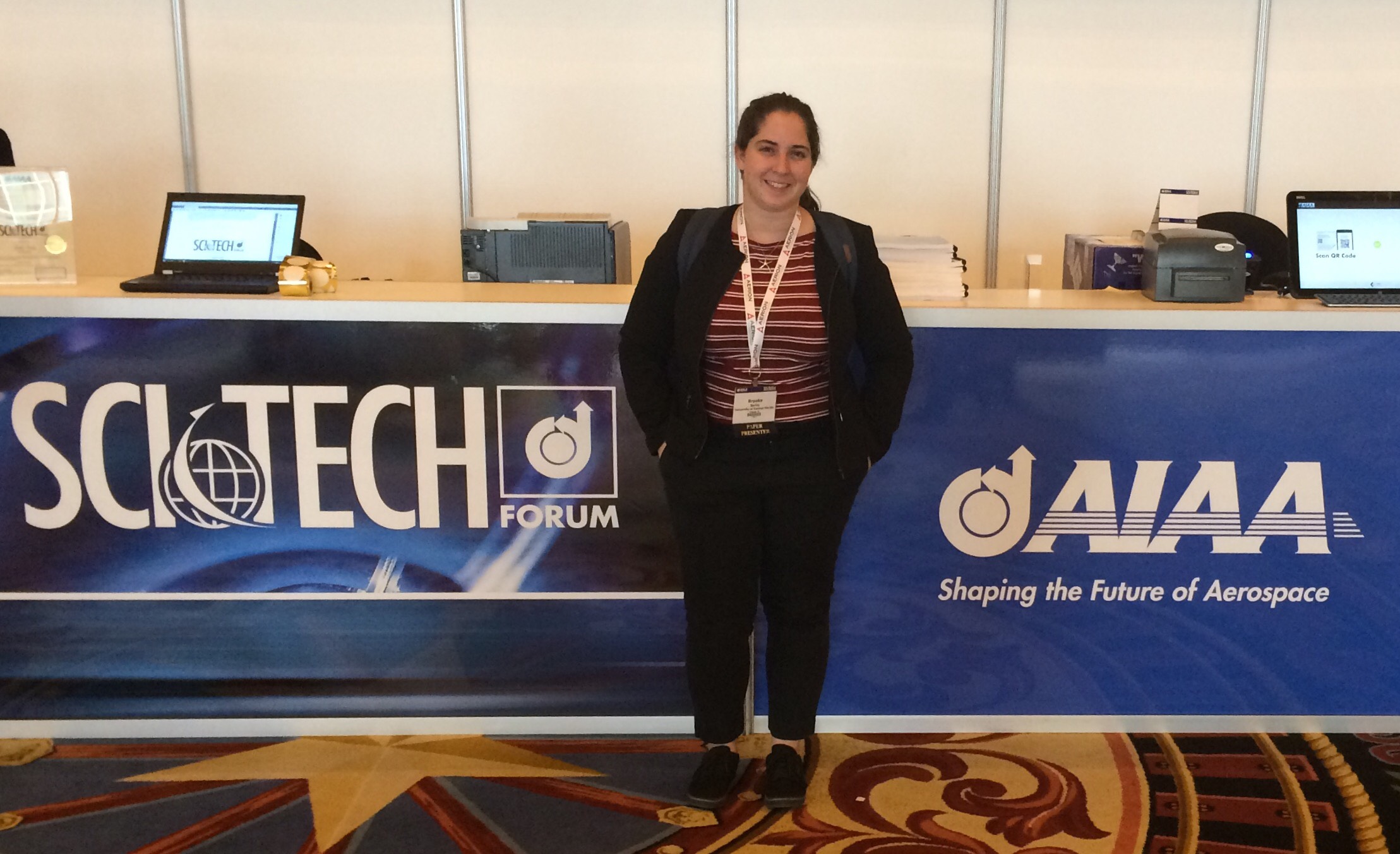

The Science and Technology Forum offers a diversity of topics, caliber of speakers, and a level of discourse about issues that directly impact the future of aerospace technology. The forum provides a unique opportunity for peers in the aerospace industry to meet and tackle the pressing challenges that face the advancement of of aerospace technology and science.
Lab group members Brooke, Quentin, Lin, and Erin will conduct pioneering in situ synchrotron thermomechanical experiments on additively manufactured high-temperature nickel alloys with our collaborators from the German Aerospace Center (DLR) and Argonne National Laboratory (ANL).
Our international collaboration with DLR and ANL that started with a summer research experience for the UCF team in Germany continues to develop with the continuation of in situ synchrotron measurements. The experiments conducted at the 1-ID beamline of the Advanced Photon Source, will capture the strain evolution in additively manufactured materials under operational environments comparable to engines.

Students from our lab have been accepted to submit to the 58th AIAA/ASCE/AHS/ASC Structures, Structural Dynamics, and Materials Conference, AIAA Science and Technology Forum and Exposition 2017.
Since its birth in 1963, AIAA has taken it upon itself to put together conferences pertaining to the aerospace profession. The AIAA Science and Technology Forum and Exposition (AIAA SciTech) gives engineers, scientists, as well as technologists the chance to showcase and distribute their work and findings in the form of technical papers and poster sessions. The conferences present the opportunity for professionals to discover new technologies and advancements from other presenters and utilize their networking skills to further their own work.
The first paper outlines the recent work conducted on hybrid carbon fiber composites and highlights major findings about material and mechanical properties of these novel materials. This will be a culmination of several different collaborations as students from the Aerostructures lab worked with Dr. Taylor’s research group from Imperial College London and Dr. Tetard’s research group in the Nanoscience center of UCF.
Brooke Sarley’s abstract submission “Real-time evolution of Selective Laser Melted (SLM) Inconel 718 with temperature through synchrotron X-rays” has been accepted to the AIAA SciTech Conference. On January 12th, she will present her work at the forum session Materials for Additive Manufacturing.
Through a research collaboration with German Aerospace Center(DLR) in Cologne, Germany, both graduate and undergraduates have the opportunity to conduct research on the mechanics of aerospace materials. Requirements for applicants include being enrolled at UCF, and being able to enroll in directed research during the Spring and Summer 2017 terms as well as participating in research activities 10-20 hours a week. Students who are accepted will have the opportunity to work with leading scientists at a state of the art facility and be able to participate in industrial visits and cultural activities. Housing and a competitive stipend are provided. The deadline to apply is October 31st.

Hohenzollern Bridge in Cologne, Germany

Former IRES students working with DLR scientists

Former IRES participant conducting an experiment at DLR
The aerostructures research group welcomes back IRES students Brooke Sarley, Jose Cotelo, Zachary Crain, and Wilson Perez. The IRES team had the opportunity to do research with DLR in Germany. While in Germany Brooke and Jose worked with Selective Laser Melted materials and analyzed their properties. Zachary and Wilson worked on analyzing properties of materials that have been exposed to high temperatures and unwanted deposits. They all had the opportunity to travel around Germany and experience the culture. Since their return, the IRES team has shared the results of their work, technical knowledge gained, and overall experiences with the rest of the aerostructures team.
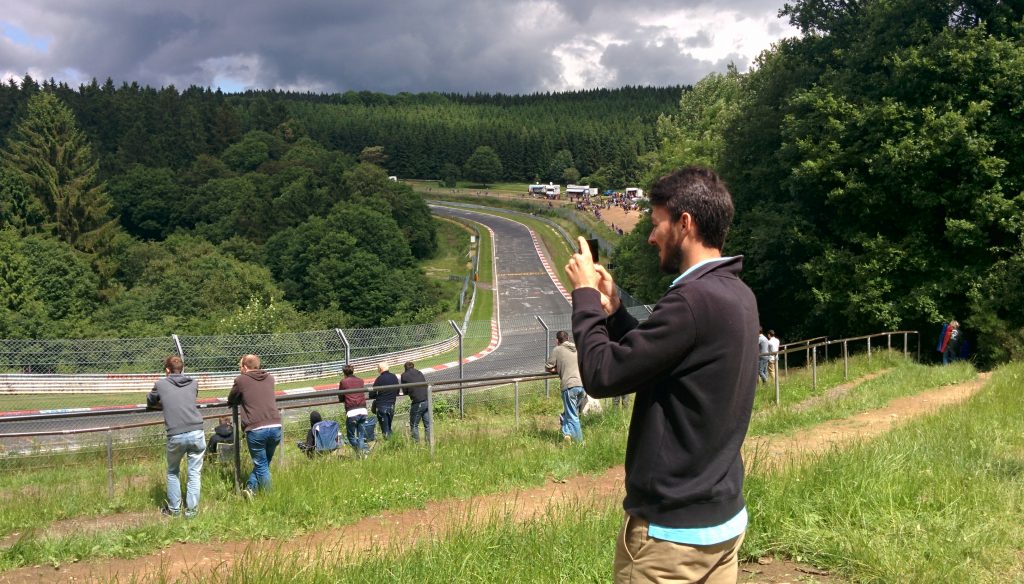
IRES students visit race track in Nürburg, Germany
 IRES students visit The Effelsberg 100-m Radio Telescope
IRES students visit The Effelsberg 100-m Radio Telescope
Members of our laboratory volunteered at a Camp Connect event at UCF. Students, from 8th to 10th grade, came from surrounding schools to engage in activities that focus on STEM related subjects. Our members oversaw an activity showing the importance of light weight structures with high strength to weight ratios. A presentation was given by our group on space structures as examples of why the strength to weight ratios are important. Following a brief presentation on aerospace structures, the students competed to build a solar sail mast with the highest strength to weight ratio. They were given some basic materials, such as index cards, straws, tape, string etc. to build their structure. At the end of the allotted time students went to the weighing station to see how much weight their structure can hold. The winners received a certificate for their accomplishment.

Examples of students’ model solar sail masts

Worksheet for the solar sail mast project, created by Lin Rossmann
Laboratory group members Alex Selimov, Alejandro Zelaya, Lin Rossmann, and Eric Barker presented two research posters at the Summer Research Academy hosted by the Office of Undergraduate Research at UCF. This event is held over two and half days during the Summer for current and incoming students to get an understanding of university research. The participants get to meet with current faculty and students involved in research, find research opportunities, and for no charge earn one credit for work before, during and after the event.
Group members Alex Selimov and Alejandro Zelaya presented “Real Time Testing of High Temperature Aerospace Materials”. The posters investigation included using Piezospectroscopy, x-ray diffraction, and x-ray tomography for a better understanding on crystal structure specific interactions.
Lin Rossmann and Eric Barker presented “Piezospectroscopy for Non-Invasive Stress Detection”. This poster describes the applications for Piezospectroscopy through depicting early crack detection and provides data from experiments conducted at UCF on various types of alumina composite coatings.

Alex Selimov and Alejandro Zelaya presenting poster on “Real Time Testing of High Temperature Aerospace Materials”
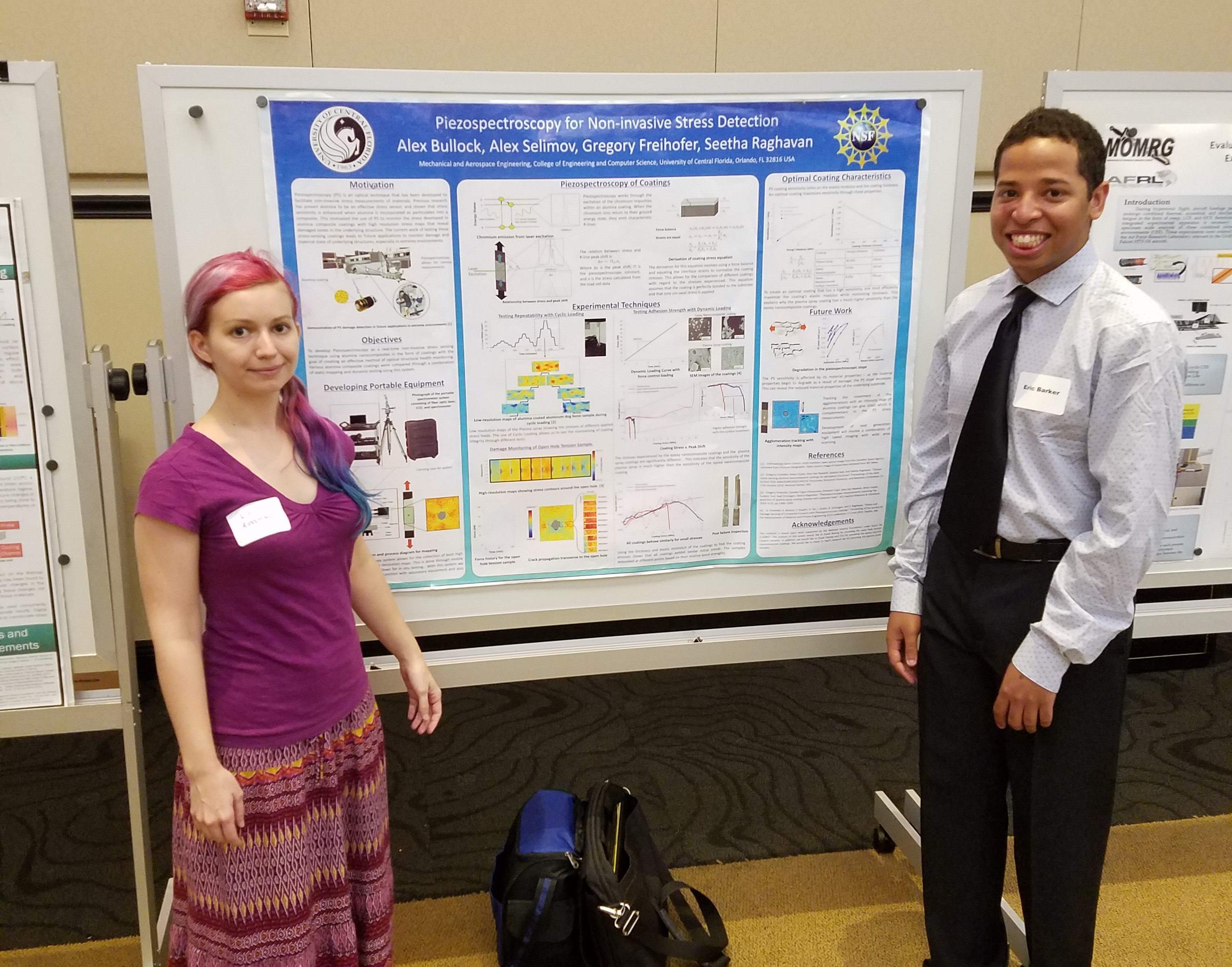
Linda Rossmann and Eric Barker presenting poster on “Piezospectroscopy for Non-Invasive Stress Detection”
Eric Barker, a participant in the L.E.A.R.N.(Learning Environment and Research Network) program recently received the Judge’s pick for the L.E.A.R.N. poster presentation. Eric is one of six recipients from a total pool of twenty eight students who will have their poster printed and presented for the Office of Undergraduate Research. The poster presentation consisted of a variety of STEM disciplines and each student had a mentor participating in research. Eric’s mentor, Alex Selimov, assisted in the creation of his poster. Eric presented the research poster “Consequences of Strain on Hybrid Carbon Fiber Composites” which is based off the work done by undergraduate Alex Selimov.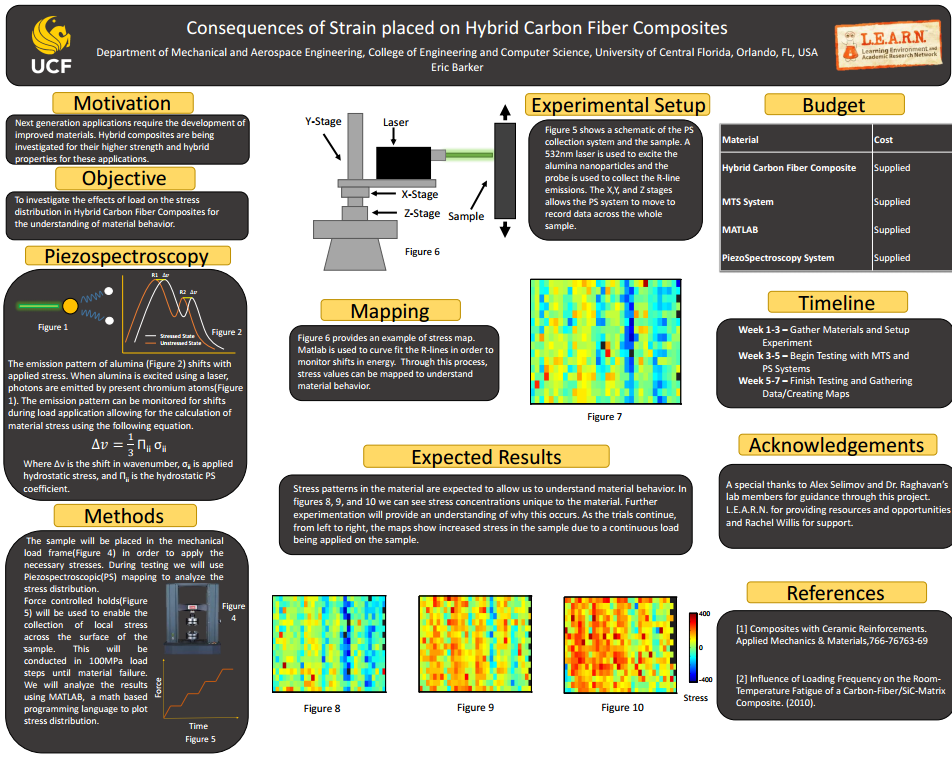

The UCF community recognized six professors who have had a national impact with their research or creative activities.
The early-career professors were given Reach for the Stars awards as part of the celebration of Founders’ Day.
President John C. Hitt selects the winners based on faculty members’ past four years of work.
Dr Raghavan was honored with this award for the exemplary research conducted by her students in UCF and internationally.


Lab group members Brooke Sarley, Alex Selimov, and Ryan Hoover gained experience presenting their research at a variety of audiences from different fields at the University of Central Florida Showcase of Undergraduate Research Excellence.
Brooke presented the research poster “Characterization of the Microstructure of SLM IN718 Under Extreme Environments”. This poster covered experiments conducted at the Advanced Photon Source at Argonne National Laboratory on Selective Laser Melted Inconel 718. Investigation objectives included investigate variation in phase composition along build direction as a result of SLM process, observe in-situ high temperature microstructure evolution, characterize role of heat treatment, and quantify residual stress and strain in as processed and heat treated SLM IN 718.
Alex and Ryan presented the research poster “Mechanical Analysis of Hybrid Carbon Fiber Reinforced with Alumina Nanoparticle via Piezospectroscopy”. This poster covered experiments conducted by students at University of Central Florida on hybrid carbon fiber reinforced with alumina particle composites. Investigation objectives included mechanical behavior of composite during mechanical testing , to investigate the stress sensitive properties of hybrid reinforced carbon fiber composites and manufacturing steps for their improvement.
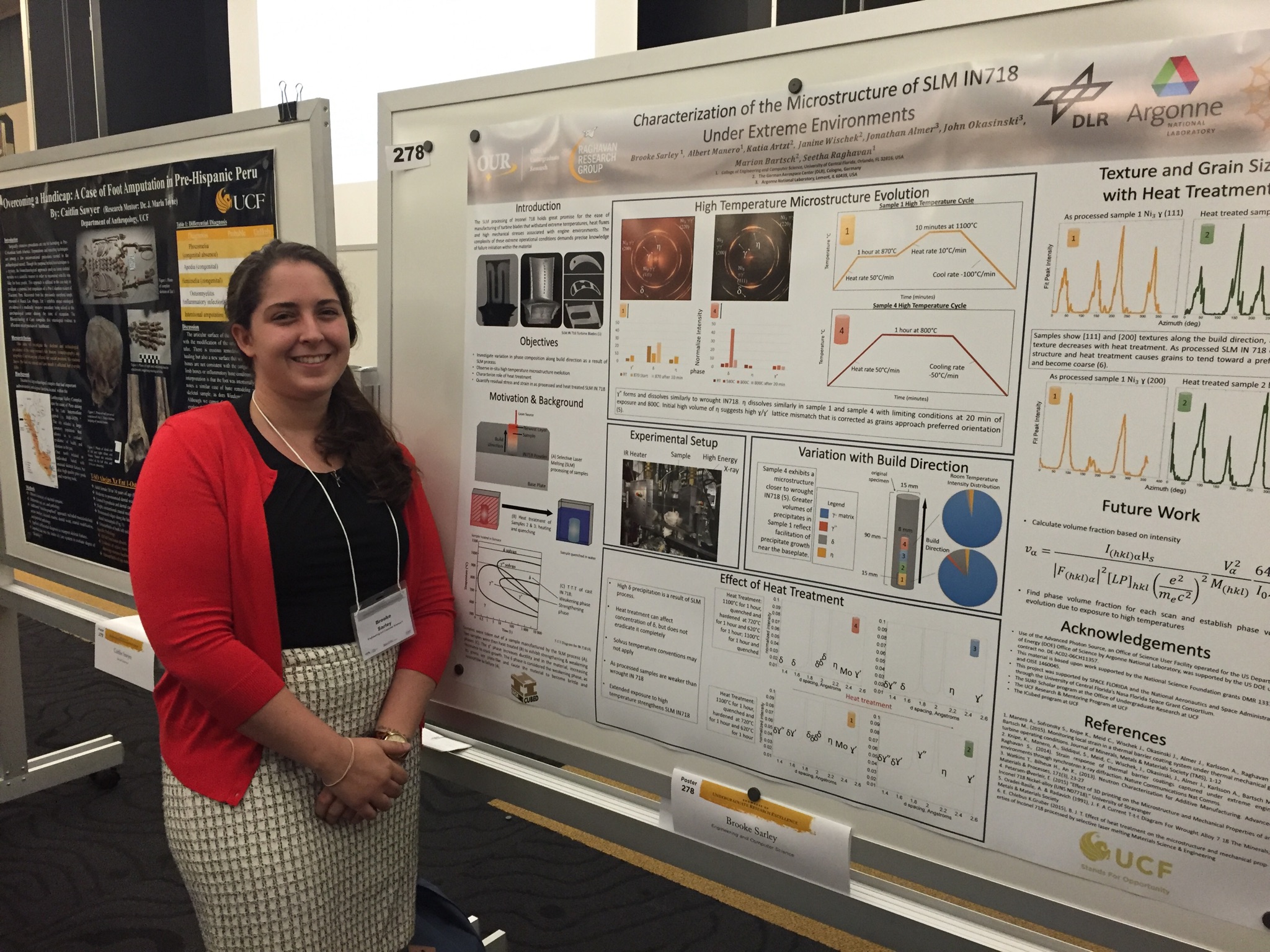
Brooke Sarley was awarded the Distinguished Undergraduate Research Award by the Office of Undergraduate Research for her work on additively manufactured alloys. This award recognizes outstanding academic research by undergraduates at the University of Central Florida.
https://www.showcase.ucf.edu
The inaugural IAGS grant program is to initiate and support faculty developing innovative faculty-led study abroad or research abroad programs, which will offer UCF students high impact international experiences. Dr. Raghavan’s program with the Imperial College in the UK aims to provide opportunities for student engagement in high impact aerospace research.
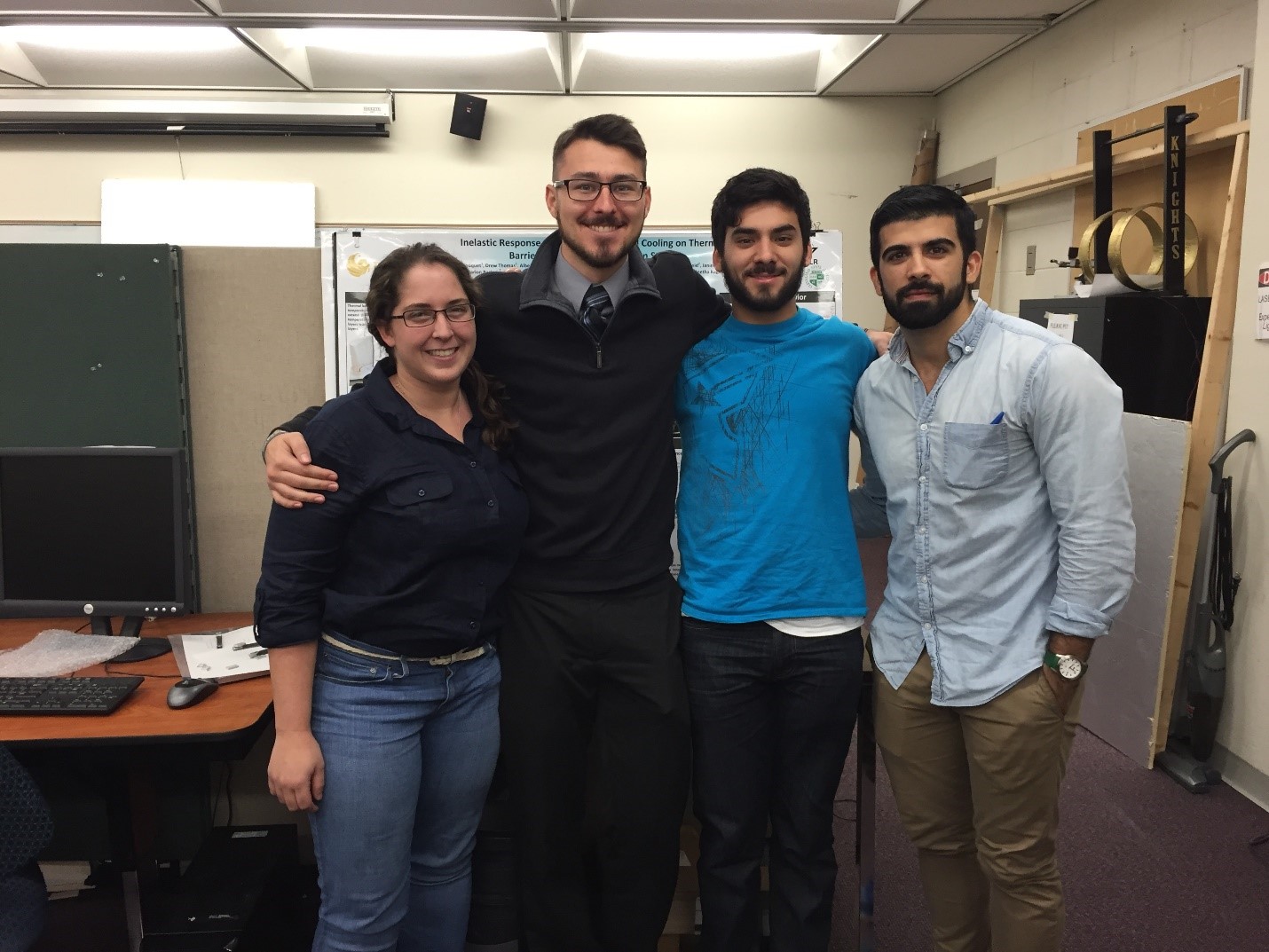
In its third year, the Life@UCF awards for the spring of 2016 celebrates our role in promoting President Hitt’s goal to “Provide international focus to our curricula and research programs”. The winning women faculty efforts best represent excellence in teaching, scholarship and/or service at a global level that has positively impacted UCF students and our institution through international efforts and collaborations. The awards were presented to the winners by Prof Cynthia Young.

Life@UCF Award winners with Prof Cynthia Young

Imad (left) and Albert (right) represented our laboratory with research presentations of their work at Scitech 2016 in San Diego.
With more than 2,500 technical abstracts from about 800 institutions in 39 countries, offering the latest research results on 44 high-impact topics, AIAA SciTech 2016 is the largest event for aerospace research, development, and technology. Our research was presented at Scitech 2016 by Imad Hanhan and Albert Manero as part of the AIAA/ASCE/AHS/ASC Structures, Structural Dynamics, and Materials Conference – one of the 12 technical conferences that make up this event. The conference provides a unique forum dedicated to the latest developments in the collective disciplines of structures, structural dynamics, materials, design engineering, and survivability.
Albert presented his research “Interpreting High Temperature Deformation Behavior of a Ceramic Matrix Composite via High Energy X-rays and Numerical Simulation” conducted in collaboration with the German Aerospace Center and Argonne National Laboratory.
Currently a graduate student at Purdue University, Imad’s research “Characterizing Mechanical Properties of Hybrid Alumina Carbon Fiber Composites with Piezospectroscopy” was part of his work for the Honors in the Major thesis conducted during his undergraduate work at UCF. The work was conducted in collaboration with Imperial College researchers.
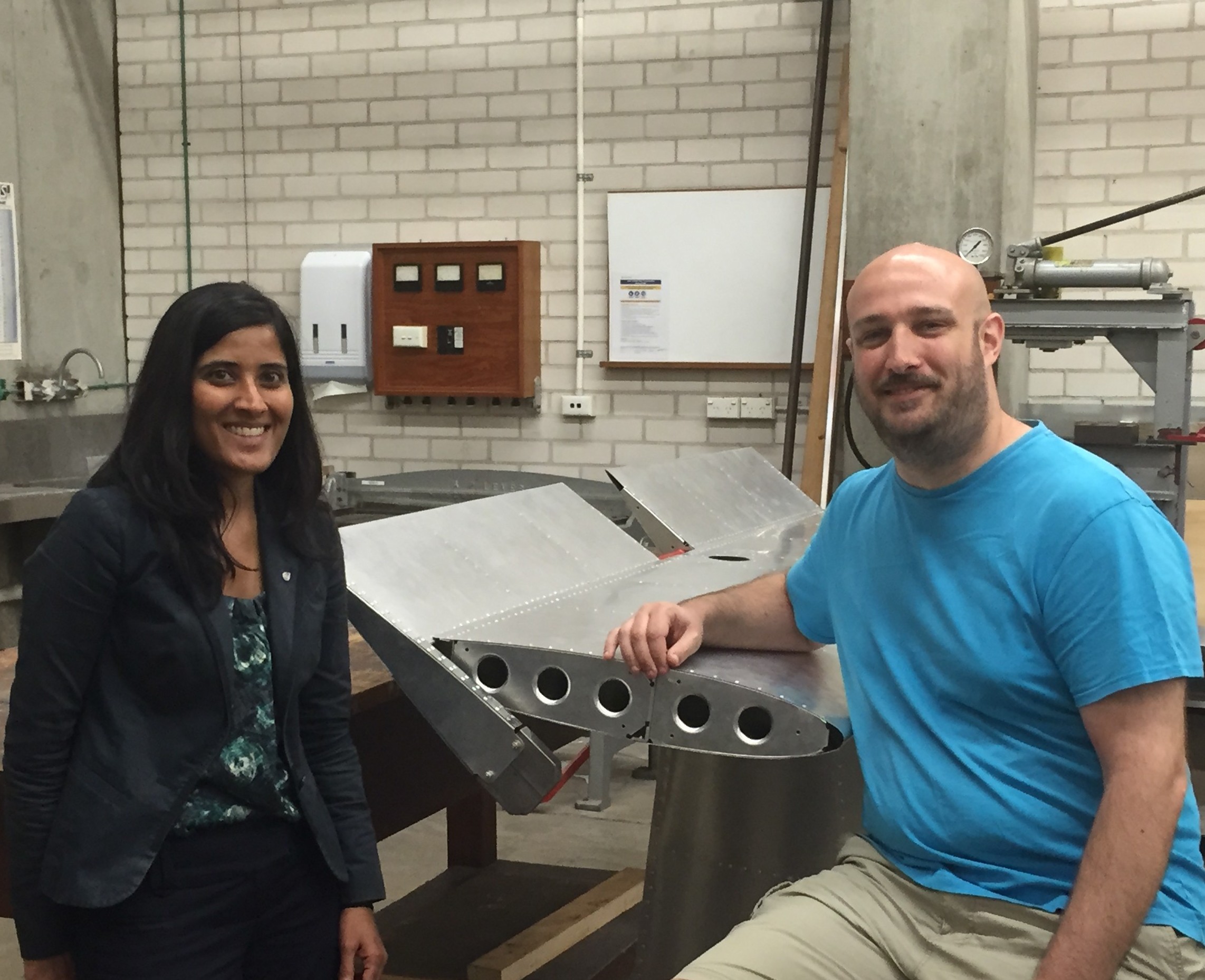
Dr Raghavan and Dr Vio at the AMME lab in the University of Sydney
The University of Sydney International Research Collaboration Awards (IRCA) are offered to researchers of high standing at anystage of their career to share and disseminate new and original ideas and/or techniques, initiate and undertake collaborative research and facilitate interaction and training of University staff and students.
This fall Dr Raghavan worked with University of Sydney host Dr Gareth Vio at the Aerospace, Mechanical and Mechatronic Engineering department on their joint proposal “Inverse design of hypersonic structures: correlating experimental mechanics at extreme environments with multi-disciplinary optimization”. The collaboration aims to extend the scope of both researchers and provide opportunities for future research and student exchange.
During the 2 months at the University of Sydney, Dr Raghavan had opportunities for discussions and exchange with faculty and students of the AMME department where she also presented her research on “Aerospace Structures in Extreme Environments” at a lunchtime talk.
Brooke Sarley attended the Society of Engineering Science conference at Texas A&M University from October 26th through the 28th. She presented her research poster on the microstructure and thermal history of Additively Manufactured Inconel 718 investigated by x-ray diffraction. Brooke was selected to receive a travel award from the Society of Engineering Sciences, organizers of the conference to cover part of her conference travel. She was also successful in receiving the UCF Office of Undergraduate Research travel grant for her presentation. SES Conferences are recognized as leading forums for bringing together diverse, interdisciplinary groups of researchers to discuss advances in highly focused symposium.
Alex Selimov participated in the RISE summer program at UC Santa Barbara. He worked with Dr Tresa Pollock and PhD student Victoria Miller on the characterization of intermetallics in Magnesium alloys and recrystallization mechanisms in Nickel superalloys. This work was presented in a university wide poster session and in the form of an intern talk.

Quentin and Brooke presenting their posters on our research at the workshop.
Brooke Sarley and Quentin Fouliard presented posters at the workshop. The posters covered their research topics in areas of X-ray diffraction of additive manufactured samples and Hybrid carbon fiber piezospectroscopic characterization respectively.
The AIAA propulsion and energy conference will take place July 27–29, 2015 in Orlando, FL.
This summer, the research team is excited to welcome three visiting students: Nick from Alabama, Aline from Brazil, and Quentin from France. They are currently working on a project regarding the characterization of an emerging hybrid carbon fiber alumina nanocmoposite through photo-luminescent spectroscopy and mechanical testing. Aline, Nick, and Quentin will continue working in the lab for the rest of this summer, and will return to their home institutions for the Fall.
Sanna Siddiqui has been awarded the Zonta International Amelia Earhart Fellowship. The Amelia Earhart Fellowship is awarded to women across the world pursuing doctoral degrees in aerospace-related engineering and science disciplines. Among the 35 Fellows awarded worldwide this year, Sanna has been honored with this award.

The high speed spectroscopy senior design team members. Left to right: Imad, Anatoliy, Devanand, Carlos, Nick, and Justin.
A senior design teams under the direction of Dr. Seetha Raghavan has completed the design of a novel high speed spectroscopy system. The team developed a technique that enables piezospectroscopy in conjunction with high strain rate testing. This technique includes a novel approach to spectral peak shift tracking which utilizes a series of etalons, PMTs, and original software, capable of detecting photo-luminescent peak shifts as fast as a few microseconds. Congratulations to the team on their graduation.

Graduate students Stephen and Sanna, and undergraduate students Imad, Alex, Hunter, and Mai welcomed a Hagerty High School Experimental Science class to the UCF Engineering department. The students were shown Dr. Seetha Raghavan’s research facility, as well as the new UCF innovation lab, and the College of Optics and Photonics.
Among the students visiting was Jack, a student mentored by Imad. Jack was awarded a number of awards both at the regional and state science fairs, and progressed to the international level.
Congratulations to Jack – a Hagerty high school senior mentored by Imad – for earning a number of awards at the regional and state level for his work in microwave propulsion. Jack has been investigating the underlying physical theories of microwave propulsion, in order to produce a more efficient and more powerful propulsion simulation and device.
At the Seminole County Regional Science, Math, and Engineering Fair, Jack won first place in Physics and Astronomy, as well as two special awards from the US Air Force, and Crooms Academy.
With his success at the regional science fair, Jack progressed to the Florida State Science and Engineering Fair, where he earned the Grand Prize/Best in Show award and First Place in Physics and Astronomy. He was also awarded two special awards from the US Air Force and NASA at the state level, and has been nominated to progress to the Intel International Science and Engineering Fair (Intel ISEF), where he will compete with the top 1,700 students in the world.
Graduate students Stephen Sofronsky and Alex Bullock, as well as undergraduate students Hunter Williams, Ryan Hoover, and Alex Selimov, led a demonstration for UCF’s Solid Mechanics class.
The student visitors had the chance to explore tensile testing of materials with advanced-sensing coatings, as well as compression testing of nano-composites in conjunction with in-situ piezospectroscopic mapping.
Congratulations to Imad for winning a National Science Foundation (NSF) graduate research fellowship. The NSF graduate research fellowship program (GRFP) is highly competitive and recognizes outstanding students’ potential “for significant achievement in science and engineering.” Nationwide, more than 16,000 students applied, and 2,000 were selected.
Imad joined the research team in the summer of 2013, and has been highly active in undergraduate research through the UCF Research and Mentoring Program (RAMP) and the NSF Innovation through Institutionalized Integration (ICubed) fellowship. Imad has also completed an Honors in the Major thesis, and will be graduating in May 2015 with honors. While researching advanced composites and stress sensing, Imad has traveled and conducted research at the Canadian Light Source, as well as Purdue University. As an undergraduate, he has also published a number of conference papers and a journal paper, and was awarded best research poster at MAE Research Day 2014, top research talk at Purdue’s Summer Research Symposium 2014, and honorable mention at UCF undergraduate research showcase 2015.
After graduating, Imad will be pursing his Master’s and Ph.D. degrees in Aeronautics and Astronautics at Purdue University.
Order of Pegasus is the most prestigious and significant award a student can attain at the University of Central Florida. Order of Pegasus recognizes exemplary performance by UCF students in the areas of academic achievement, outstanding university involvement, leadership, and community service. Albert was one of 19 students inducted to the prestigious Order of Pegasus Class of 2015. See the news article here.
The piezospectroscopic effect, relating a material’s stress state and spectral signature, has recently demonstrated tailorable sensitivity when the photo-luminescent alpha alumina is distributed in nanoparticulate form within a matrix. Here, the stress- sensing behavior of an alumina-epoxy nanoparticle coating, applied to a compos- ite substrate in an open hole tension configuration, is validated with the biaxial strain field concurrently determined through digital image correlation. The coating achieved early detection of composite failure initiation at 77% failure load, and subsequently tracked stress distribution in the immediate vicinity of the crack as it progressed, demonstrating non-invasive stress and damage detection with multi-scale spatial resolution.
The Showcase of Undergraduate Research Excellence (SURE) is a poster- or display-based forum for UCF undergraduates to present their research and creative projects to the broader university community. This year 4 posters from our research were presented at the Showcase. Alex (right) presented work on high strain rate studies while Imad (left) presented his Honors in the major work on Hybrid composites. Imad won an Honorable Mention award for his poster.
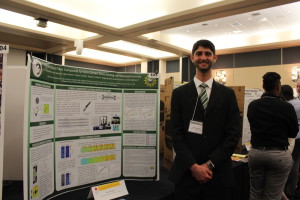
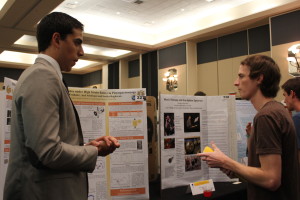
Hunter’s poster (left) described novel thermal mechanical testing instrumentation while Drew (right) presented Inelastic behavior observed in thermal gradient mechanical load studies of thermal barrier coatings.

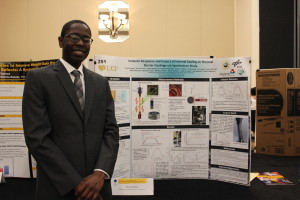
We were joined by the Limbitless team with their excellent posters on various aspects of the 3D printed design of their bionic arm.
The Showcase of Undergraduate Research is a poster/display based forum for UCF undergraduates to present their research and creative projects to a broader university community.
Albert is preparing for our next set of challenging experiments while on a Fulbright Fellowship under the mentorship of Prof Marion Bartsch and colleagues at DLR Aerospace, Cologne, Germany. Read his recent blog on the Fulbright website on how the international experience has made a difference in his quest to achieve his research and personal goals.
Learn more about the Fulbright program